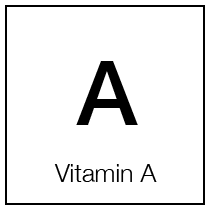
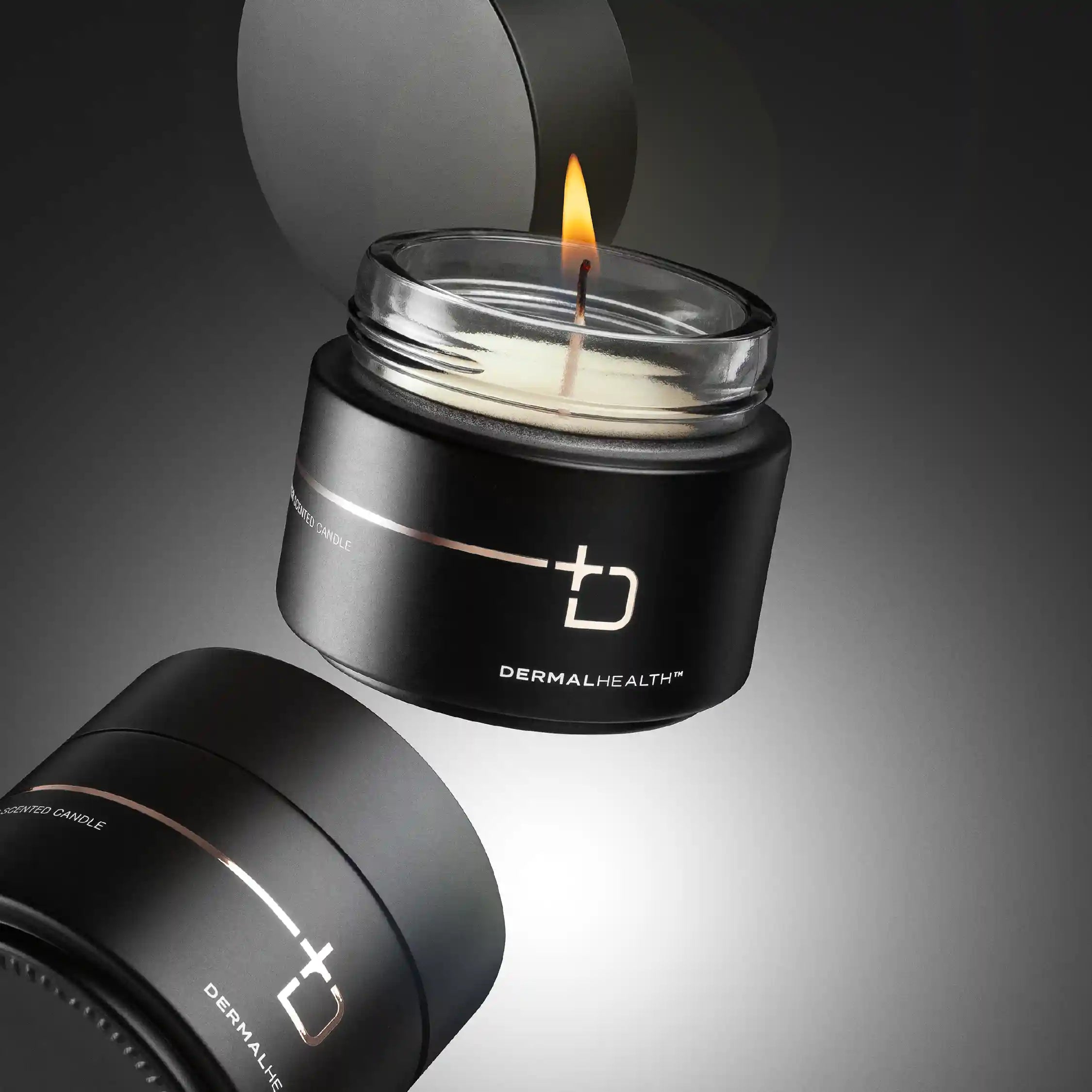




The Ultimate Pampering Experience for the Supermom

Moisturizing

Firming

anti-aging

↑ circulation

smooth skin
Free Gift with The Mom Gift:

Microfibre Sponge




SHIPPING
- Shipping Guarantee: Guiding you to healthy skin isn’t only about our products; it's also about getting them to you as swiftly as the science behind them. That's why Dermal Health offers a shipping guarantee you can rely on.
- Where We Ship From: Orders are dispatched from our facilities in Pretoria.
- Who We Ship With: We trust only well-known, popular, and dependable courier services with your packages.
- When You'll Get It: Expect confident skin soon! Shipping addresses in Pretoria and Johannesburg will enjoy delivery from same-day to 2 business days. Shipping addresses further from Pretoria may expect delivery within 1-4 business days, depending on the service you select during checkout. Your estimated delivery date will reflect during checkout so that you can mark your calendar.
- Tracking Your Order: Eager to start your DermExcel journey? We don't blame you! You'll receive a tracking number after you place your order so that you can follow your package.
For any shipping inquiries, our customer service team is ready to assist.
SECURE PAYMENT
Dermal Health Science 30-Day Confidence Guarantee: We are passionate about guiding you to healthy skin through medical science. We believe in the quality and effectiveness of our products so much that we offer a 30-Day Confidence Guarantee.
If you're unsatisfied with your purchase, simply return it within 30 days for a full refund.
Healthy Skin Is Not Complicated and neither is our return policy. Please visit our detailed return policy or contact our friendly customer service team for more information.
Feel as confident in us as we want you to feel in your skin.

Choose options


The Ultimate Pampering Experience for the Supermom
Celebrate the incredible mom in your life with The Mom Gift, a luxurious collection designed to nourish her skin and give her the pampering she truly deserves. Combining advanced skincare with elegant accessories, this thoughtfully curated set will leave her feeling refreshed, radiant, and deeply appreciated.
What’s Inside
DermExcel Cleanser – Tailored for Her Skin
Because every mom’s skin is unique, you get to choose the perfect cleanser to complement her skincare routine.
The choice is yours:
- Renewal Facial Cleanser: A revitalizing treatment cleanser designed to exfoliate, brighten, and renew the skin. Powered by a triple-acid complex of 3% Salicylic acid, 1% Mandelic acid, and 5% Glycolic acid, it effectively removes dead skin cells, unclogs pores, and promotes a smoother, more radiant complexion. Ideal for dull, uneven, or breakout-prone skin.
- Pore Control Cleanser: For moms with oily or acne-prone skin, this cleanser features 3% Salicylic acid to regulate sebum, unclog pores, and reduce inflammation, leaving skin clear and balanced.
- Medi-Zinc Cleanser: A soothing, hypoallergenic cleanser with Zinc Pyrithione to calm irritated or sensitive skin, perfect for reducing redness and inflammation.
Simply select the ideal cleanser for her skin type on the product page, and create a personalized skincare experience.
Time Freeze Eye Serum
Turn back the clock with the Time Freeze Eye Serum, a powerful treatment designed to combat the signs of aging around the delicate eye area. This advanced formula reduces puffiness, dark circles, and fine lines, delivering a smoother, brighter, and more youthful appearance. Enriched with potent anti-aging ingredients, it’s the perfect pick-me-up for tired eyes, giving mom a refreshed, well-rested look no matter how busy her day gets.
DermNourish Moisturizer
Give her skin the comfort it deserves with DermNourish, a deeply restorative moisturizer that delivers lasting hydration and supports a healthy skin barrier. Its rich, silky texture absorbs easily, leaving the skin feeling soft, smooth, and nourished. Whether used daily or during times of dryness and stress, DermNourish helps maintain skin’s natural balance and radiance.
Voyageur Noir Pouch
Refined functionality meets everyday luxury with this Voyageur Noir Pouch. Sleek and structured, this matte silicone-coated pouch is soft to the touch yet exceptionally durable. With three integrated card slots, an interior zip compartment, and a secure snap-button strap for keys or accessories, it’s perfect for the modern mom on the move. Elegant and practical, it keeps her essentials close—whether she’s traveling or tackling a busy day.
DermExcel™ Headband
Complete her skincare ritual with the DermExcel™ Headband, crafted from soft microfibre fabric for maximum comfort. With its secure velcro closure, it keeps hair neatly in place while she cleanses, masks, or applies her favorite treatments, adding a touch of spa-like luxury to her daily routine.
The Silent Prayer Candle
Infused with our signature Silent Prayer fragrance, this elegant candle features notes of rich Ebony Agarwood, with warm, earthy undertones that create a calming and grounded atmosphere. It’s the perfect addition to her self-care ritual—designed to evoke stillness, reflection, and quiet luxury.
Renewal
/Pore Control Cleanser
/Medi-Zinc Cleanser
Cleanser - 175ml(Depending on your selection)
active ingredients in this gift pack
Hydrotensyl Complex
An active ingredient made from the combination of 3 powerful actives with extraordinary benefits for the skin:
- Honey Extract
- Marine native Collagen
- Marine Hydrolyzed Elastin
Honey Extract
- Provides natural moisturising factor analogue substances to skin cells.
- It also provides the skin with components with a vital capacity for hydro-retention and hydro-regulation.
- Mechanisms of action on skin cells include antioxidant activity and the induction of cytokines, and matrix metalloproteinase expression.
Marine native Collagen
Native Collagen has a high molecular weight, that leaves a protective film on the skin with tensor effects and remarkable moisturizing capabilities.
Marine Hydrolyzed Elastin
- Provide nutrients and amino acids that the fibroblasts (type of skin cell) will use to produce new fibres of elastin and collagen.
- It contains the peptides and amino acids of elastin: Aspartic Acid, Theorine, Serine, Glutamic Acid, Proline, Glycine, Lysine, and Arginine.
It is a complete active ingredient from which the skin will get substances to nourish, increase its moisture, get external protection against damaging substances, and decrease its wrinkles.
Niacinamide
Niacinamide offers several benefits for the skin, primarily due to its anti-inflammatory and antioxidant properties. It reduces the redness and inflammation associated with acne, rosacea, and other inflammatory skin conditions. Additionally, niacinamide's ability to improve the skin's barrier function benefits all skin types, particularly those with eczema or mature skin.
Another significant benefit of niacinamide is its role in reducing hyperpigmentation. Studies have shown that it can decrease the transfer of melanin to the epidermis, helping to fade dark spots and even out skin tone.
Niacinamide also plays a role in reducing the visible signs of aging. It has been found to stimulate collagen production and improve skin elasticity, reducing fine lines and wrinkles. Its antioxidant properties further protect the skin from environmental damage, such as pollution and UV radiation, which contribute to premature aging.
The efficacy of niacinamide and its ability to address multiple skin concerns simultaneously has led to its growing popularity in both over-the-counter and prescription skincare formulations.
Physiological Effects
- Barrier Function Enhancement: Niacinamide helps strengthen the skin’s barrier function by increasing the production of ceramides, lipids that keep the skin hydrated and protect against environmental damage.
- Anti-inflammatory Properties: It has notable anti-inflammatory effects, which are beneficial in reducing redness and inflammation associated with acne, eczema, and other inflammatory skin conditions.
- Sebum Regulation: Niacinamide helps regulate sebum production, which controls excess oiliness and can benefit acne-prone skin.
- Hyperpigmentation Reduction: It reduces hyperpigmentation by inhibiting melanosome transfer from melanocytes to keratinocytes, leading to an even skin tone.
- Anti-aging Effects: Niacinamide helps reduce the appearance of fine lines and wrinkles by boosting collagen production and improving skin elasticity.
- Antioxidant Activity: It has antioxidant properties, protecting the skin from oxidative stress and environmental aggressors like UV radiation and pollution.
Managing Dermatological Conditions
- Acne and Oily Skin: Niacinamide effectively manages acne and oily skin by regulating sebum and reducing inflammation.
- Hyperpigmentation and Melasma: Its ability to reduce melanin transfer benefits it in treating hyperpigmentation and melasma.
- Aging Skin: Niacinamide targets wrinkles and loss of firmness.
- Skin Barrier Disorders: Niacinamide is beneficial in treating skin barrier disorders like atopic dermatitis and eczema by enhancing barrier function and hydration.
- Photodamage and Skin Protection: It helps mitigate the effects of photodamage and provides some degree of protection against environmental damage.
References
- Gehring, W. (2004). Nicotinic acid/niacinamide and the skin. Journal of Cosmetic Dermatology.
- Bissett, D. L., Oblong, J. E., & Berge, C. A. (2005). Niacinamide: A B vitamin that improves aging facial skin appearance. Dermatologic Surgery.
- Snaidr, V. A., Damian, D. L., & Halliday, G. M. (2019). Nicotinamide for photoprotection and skin cancer chemoprevention: A review of efficacy and safety. Experimental Dermatology.
- Navarrete-Solís, J. et al. (2011). A Double-Blind, Randomized Clinical Trial of Niacinamide 4% versus Hydroquinone 4% in the Treatment of Melasma. Dermatology Research and Practice, 2011.
Hyaluronic acid
Hyaluronic acid (HA) is a naturally occurring glycosaminoglycan found throughout the body's connective, epithelial, and neural tissues. Most abundantly present in the skin, eyes, and synovial fluid, HA is renowned for its exceptional capacity to retain moisture — a single gram can hold up to six liters of water.
In skincare, the primary appeal of hyaluronic acid lies in its unparalleled hydrating abilities. As a humectant, HA attracts and retains moisture from the environment, providing intense hydration to the skin. This hydrating property contributes significantly to maintaining skin plumpness, suppleness, and elasticity.
Beyond hydration, hyaluronic acid also plays a vital role in skin repair and regeneration. It supports the skin's healing and repair processes, and its anti-inflammatory properties help calm irritated skin. Moreover, HA's ability to promote collagen production, a crucial protein for skin elasticity, further underscores its anti-aging benefits.
The molecular size of hyaluronic acid influences its skin penetration and efficacy. High-molecular-weight HA remains on the skin's surface, providing hydration and forming a barrier against moisture loss. In contrast, low-molecular-weight HA penetrates deeper into the skin's layers, offering more profound hydrating and rejuvenating effects.
Hyaluronic acid's remarkable ability to hydrate, improve skin elasticity, aid in wound healing, and provide antioxidant protection makes it valuable in managing various dermatological conditions, particularly aging, dryness, and sensitive skin.
Physiological Effects
- Hydration: Hyaluronic acid is a powerful humectant that can hold up to 1000 times its weight in water, significantly enhancing skin hydration and leading to plumper, more hydrated skin.
- Skin Elasticity and Wrinkle Reduction: By increasing skin moisture, it improves skin elasticity, reduces the appearance of fine lines and wrinkles, and gives the skin a more youthful appearance.
- Wound Healing: It plays a role in wound healing due to its ability to regulate inflammation levels and signal the body to build more blood vessels in the damaged area.
- Barrier Enhancement: Hyaluronic acid helps reinforce the skin's natural barriers, protecting against environmental factors and retaining moisture.
- Antioxidant Properties: It provides antioxidant defense against free-radical damage from the sun and pollution.
Managing Dermatological Conditions
- Aging Skin: Its ability to reduce wrinkles and improve skin elasticity makes it popular in anti-aging skincare products.
- Dry Skin: Hyaluronic acid is beneficial in treating dry skin conditions by providing intense hydration.
- Wound Care: Its role in wound healing is leveraged in post-procedure care, such as after laser treatments, and in healing minor cuts and abrasions.
- Acne Scars: It can help treat acne scars by promoting skin regeneration and reducing inflammation.
- Sensitive Skin: Hyaluronic acid is suitable for sensitive skin due to its gentle nature. It provides hydration without irritating.
References
- Papakonstantinou, E., Roth, M., & Karakiulakis, G. (2012). Hyaluronic acid: A key molecule in skin aging. Dermato-endocrinology.
- Jegasothy, S. M., Zabolotniaia, V., & Bielfeldt, S. (2014). Efficacy of a new topical nano-hyaluronic acid in humans. The Journal of Clinical and Aesthetic Dermatology.
- Wollina, U., & Abdel-Naser, M. B. (2019). Hyaluronic acid in the treatment and prevention of skin diseases: Molecular biological, pharmaceutical and clinical aspects. Skin Pharmacology and Physiology.
d-Panthenol
d-Panthenol's multifaceted effects on skin hydration, barrier strengthening, and wound healing make it a valuable component in the management of various dermatological conditions, from dry skin to post-procedure care.
d-Panthenol, also known as pro-vitamin B5, is a popular dermatological ingredient due to its beneficial effects on the skin. Here's a brief overview of its physiological effects and roles in managing various skin conditions:
Physiological Effects
- Hydration: d-Panthenol is a humectant, meaning it helps to attract and retain moisture in the skin. This leads to increased skin hydration, which can improve skin softness and elasticity.
- Wound Healing and Repair: It plays a role in the synthesis of lipids and proteins, essential for skin repair. d-Panthenol has been shown to accelerate re-epithelialization in wound healing.
- Anti-Inflammatory Effect: d-Panthenol can reduce inflammation, making it beneficial in treating skin irritations and erythema.
- Skin Barrier Strengthening: By enhancing the synthesis of lipids and proteins, d-Panthenol contributes to the strengthening of the skin's barrier function, protecting against irritants and environmental damage.
- Soothing and Softening: It soothes the skin and makes it feel softer and smoother, which can be particularly beneficial for dry or rough skin textures.
Managing Dermatological Conditions
- Minor Wounds and Skin Irritations: Due to its role in skin repair and anti-inflammatory properties, d-Panthenol is used in the treatment of minor wounds, cuts, and skin irritations.
- Dermatitis and Eczema: It helps in managing conditions like dermatitis and eczema by reducing inflammation and enhancing skin barrier function.
- Dry Skin Conditions (Xerosis): Its moisturizing properties make it effective in treating dry skin, providing relief from itching and scaling.
- Post-procedure Care: d-Panthenol is often used in post-procedure care, such as after laser treatments or chemical peels, to aid in skin recovery and reduce inflammation.
References
- Proksch, E., & Nissen, H. P. (2002). Dexpanthenol enhances skin barrier repair and reduces inflammation after sodium lauryl sulphate-induced irritation. Journal of Dermatological Treatment.
- Ebner, F., Heller, A., Rippke, F., & Tausch, I. (2002). Topical use of dexpanthenol in skin disorders. American Journal of Clinical Dermatology.
- Camargo, F. B. Jr, Gaspar, L. R., & Maia Campos, P. M. B. G. (2011). Skin moisturizing effects of panthenol-based formulations. Journal of Cosmetic Science.
Ceramides
Ceramides, a family of lipid molecules naturally present in the skin, are integral to the structure and function of the skin barrier. They are a type of lipid that, along with cholesterol and fatty acids, forms a critical part of the stratum corneum, the outermost layer of the skin. This layer is essential for maintaining skin hydration and protecting against environmental aggressors.
Ceramides, which make up about 50% of the skin's lipid composition, play a pivotal role in maintaining the skin's barrier integrity and preventing transepidermal water loss (TEWL). By doing so, they help keep the skin hydrated and supple.
The loss or reduction of ceramides in the skin barrier is associated with several dermatological conditions, including eczema and psoriasis, where the skin becomes dry, itchy, and prone to irritation and infection. Studies have shown that the application of ceramide-containing moisturizers can effectively improve skin barrier function and increase skin hydration levels.
Ceramides are particularly beneficial for aging skin, which naturally loses ceramides over time, leading to drier and more fragile skin. By replenishing the skin's ceramide content, these products can help combat the signs of aging, such as fine lines and wrinkles.
Ceramides are integral to maintaining skin health, particularly in conditions where the skin barrier is compromised. Their role in hydrating the skin, reducing sensitivity, and improving barrier function makes them an essential component in the management of various dermatological conditions, especially eczema, psoriasis, and dry or aging skin.
Physiological Effects
- Barrier Function: Ceramides are critical components of the skin's lipid barrier. They help to prevent moisture loss and protect against environmental aggressors like pollutants and irritants.
- Hydration: By maintaining the barrier integrity, ceramides keep the skin hydrated, preventing dryness and keeping the skin supple.
- Reducing Skin Sensitivity: They play a role in reducing skin sensitivity and irritation, helping to calm inflamed and reactive skin.
- Anti-aging Properties: Ceramides can improve skin elasticity and firmness, helping to reduce the appearance of fine lines and wrinkles.
- Wound Healing: There is evidence to suggest that ceramides can aid in the skin's natural wound healing process.
Managing Dermatological Conditions
- Eczema and Atopic Dermatitis: Ceramides are often used in the treatment of eczema and atopic dermatitis, where the skin barrier is compromised, leading to dryness, itching, and inflammation.
- Psoriasis: They can help in managing psoriasis by maintaining skin hydration and barrier function, reducing scaling and dryness.
- Aging Skin: Ceramide-containing products are beneficial in anti-aging regimens due to their ability to improve skin barrier function and elasticity.
- Dry Skin (Xerosis): In the treatment of dry skin, ceramides help in restoring skin hydration and barrier function.
- Sensitive Skin: Products containing ceramides are suitable for sensitive skin as they help to restore the skin's natural barrier and reduce irritation.
References
- Del Rosso, J. Q., & Levin, J. (2011). The clinical relevance of maintaining the functional integrity of the stratum corneum in both healthy and disease-affected skin. Journal of Clinical and Aesthetic Dermatology.
- Farwanah, H., Wohlrab, J., Neubert, R. H. H., & Raith, K. (2005). Ceramides and skin function. American Journal of Clinical Dermatology.
- Di Nardo, A., Wertz, P., Giannetti, A., & Seidenari, S. (1998). Ceramide and cholesterol composition of the skin of patients with atopic dermatitis. Acta Dermato-Venereologica.
Humectants
Humectants are a vital component in skincare, particularly for conditions characterized by impaired skin barrier function and excessive dryness. Their ability to attract and retain moisture in the skin makes them invaluable in both therapeutic and preventive dermatology.
Physiological Effects
- Moisture Attraction: Humectants draw moisture from the environment and the deeper layers of the skin to the outer layer (stratum corneum), enhancing skin hydration.
- Enhancing Skin Barrier Function: By improving skin hydration, humectants help to maintain and improve the skin's barrier function, protecting against irritants and reducing transepidermal water loss (TEWL).
- Skin Elasticity and Appearance: Improved hydration can enhance skin elasticity and reduce the appearance of fine lines and wrinkles, giving the skin a plumper and smoother look.
- Soothing Effect: Humectants can have a soothing effect on the skin, particularly in conditions involving dryness or irritation.
Managing Dermatological Conditions
- Dry Skin (Xerosis): Humectants are key ingredients in many moisturizers and are highly effective in managing dry skin by providing and maintaining hydration.
- Eczema and Dermatitis: Their moisturizing and soothing properties help in relieving symptoms of eczema and dermatitis, such as dryness, itching, and irritation.
- Aging Skin: Humectants are used in anti-aging skincare products due to their ability to hydrate the skin and improve its appearance.
- Psoriasis: They can aid in reducing the dryness and scaling associated with psoriasis.
- Acne-Prone Skin: Certain humectants can be beneficial in acne treatments, as they provide necessary hydration without clogging pores.
References
- Lodén, M. (2005). Role of Topical Emollients and Moisturizers in the Treatment of Dry Skin Barrier Disorders. American Journal of Clinical Dermatology.
- Rawlings, A. V., & Canestrari, D. A. (2011). Moisturizer technology versus clinical performance. Dermatologic Therapy.
- Fluhr, J. W., Darlenski, R., & Surber, C. (2008). Glycerol and the skin: holistic approach to its origin and functions. British Journal of Dermatology.
Emollients
Emollients are crucial in dermatological care, primarily because they enhance skin hydration and barrier function. Here's a brief overview of their physiological effects and roles in managing various skin conditions.
Physiological Effects
- Hydration of Stratum Corneum: Emollients increase moisture content in the stratum corneum, the outermost layer of the skin, by reducing transepidermal water loss (TEWL). This is achieved through occlusion, which traps water in the skin.
- Restoration of Skin Barrier Function: They aid in replenishing the skin's lipid barrier, which is essential for maintaining skin integrity and protective function.
- Soothing and Smoothing Effects: Emollients smooth, flaky skin cells, making the skin surface appear smoother. They also provide a soothing effect, which can reduce itching and discomfort.
- Anti-inflammatory Properties: Some emollients have ingredients that offer mild anti-inflammatory benefits, helping to reduce redness and irritation.
Managing Dermatological Conditions
- Atopic Dermatitis (Eczema): Emollients are a cornerstone in the management of eczema, helping to maintain skin hydration, reduce flare-ups, and minimize the need for topical corticosteroids.
- Psoriasis: Regular use of emollients can reduce scaling and dryness associated with psoriasis, improving the efficacy of other topical treatments.
- Ichthyosis and Xerosis: These conditions, characterized by dry, scaly skin, benefit significantly from emollients, which help hydrate and soften the skin.
- Aging Skin: Emollients improve the appearance of aging skin by hydrating and reducing the visibility of fine lines and wrinkles.
- Skin Protection: Emollients can protect the skin from irritation and breakdown in individuals with incontinence or those who are bedridden.
References
- Proksch, E., & Lachapelle, J. M. (2005). The Management of Dry Skin with Topical Emollients. American Journal of Clinical Dermatology.
- Lynde, C. W. (2001). Moisturizers: What They Are and a Practical Approach to Product Selection. Skin Therapy Letter.
- Lodén, M. (2003). Role of Topical Emollients and Moisturizers in the Treatment of Dry Skin Barrier Disorders. American Journal of Clinical Dermatology.
Vitamin A
Vitamin A, a fat-soluble vitamin, is critical in maintaining healthy skin, vision, and overall immune function. In dermatology, it is particularly celebrated for its potent effects on skin health and its use in treating a variety of skin conditions.
There are two primary forms of vitamin A: retinoids (including retinol), which are found in animal products, and carotenoids, which are present in plants. Retinoids are biologically active and are used both topically and systemically in dermatology. Topical retinoids, such as tretinoin and adapalene, are widely used in treating acne and photoaging because they regulate skin cell turnover and boost collagen production, resulting in clearer and smoother skin.
Vitamin A's role in promoting cell turnover helps to unclog pores and reduce the severity of acne. It also aids in diminishing the appearance of fine lines and wrinkles, making it a key ingredient in many anti-aging skincare products. Additionally, vitamin A can help normalize this process in the treatment of psoriasis, a condition characterized by excessive skin cell production.
Vitamin A also possesses antioxidant properties, which help protect the skin from damage caused by free radicals and environmental aggressors like UV radiation and pollution.
Physiological Effects
- Cellular Turnover: It stimulates cell turnover in the skin. This means it helps shed old skin cells and replace them with new ones, improving skin texture and tone.
- Collagen Production: It aids in collagen production, essential for maintaining skin elasticity and reducing the appearance of fine lines and wrinkles.
- Regulation of Sebum Production: Help regulate sebum production, which is beneficial for acne-prone skin.
- Pigmentation: It assists in regulating skin pigmentation, helping to even out skin tone and reduce the appearance of dark spots.
- Photoprotection: Antioxidant properties that protect the skin from damage caused by UV rays.
Managing Dermatological Conditions
- Acne: Vitamin A derivatives, like retinoids, are highly effective in treating acne by preventing clogged pores and reducing inflammation.
- Aging Skin: Topical retinoids reduce signs of aging, such as wrinkles and fine lines, by boosting collagen production.
- Psoriasis: Vitamin A can help manage psoriasis by normalizing skin cell growth.
- Hyperpigmentation: It helps treat hyperpigmentation and melasma by accelerating skin cell turnover.
- Sun Damage: Vitamin A's antioxidant properties can help to some extent in repairing and preventing sun damage.
References
- Mukherjee, S., Date, A., Patravale, V., Korting, H. C., Roeder, A., & Weindl, G. (2006). Retinoids in the treatment of skin aging: an overview of clinical efficacy and safety. Clinical Interventions in Aging, 1(4), 327–348.
- Kang, S., et al. (2005). Topical Retinoids. In: Fitzpatrick's Dermatology in General Medicine.
- Kafi, R., et al. (2007). Improvement of Naturally Aged Skin With Vitamin A (Retinol). Archives of Dermatology.
Vitamin E
The fat-soluble Vitamin E's benefits in maintaining skin health and appearance are well-acknowledged in both cosmetic and clinical dermatology. Comprising a group of eight compounds, including four tocopherols and four tocotrienols, Vitamin E is known for its role in protecting cell membranes from oxidative damage.
Vitamin E is celebrated in skincare for its ability to neutralize free radicals caused by environmental stressors such as UV radiation and pollution. These free radicals can lead to premature skin aging, making Vitamin E a valuable ingredient in anti-aging skincare products. Its antioxidant action helps to protect the skin from damage, reduce the appearance of wrinkles, and improve skin texture and tone.
Additionally, Vitamin E is known for its moisturizing benefits. It helps to strengthen the skin barrier, reduce moisture loss, and keep the skin hydrated and supple. This makes it especially beneficial for dry and damaged skin.
Vitamin E also has anti-inflammatory properties, making it beneficial in soothing and calming irritated skin. This has implications for conditions such as dermatitis and acne, where inflammation plays a key role.
Physiological Effects
- Antioxidant Protection: Vitamin E neutralizes harmful free radicals in the skin, preventing oxidative stress and damage caused by environmental factors like UV radiation and pollution.
- Moisturization: It has moisturizing properties, helping to improve skin hydration and alleviate dryness.
- Wound Healing: Vitamin E may assist in the skin's healing process, although its efficacy in wound healing is still a subject of research.
- Photoprotection: While not a sunscreen, it can provide some degree of photoprotection by strengthening the skin's defense against UV-induced damage.
- Anti-Inflammatory Effects: It helps reduce skin inflammation and is beneficial in managing conditions like eczema and psoriasis.
Managing Dermatological Conditions
- Skin Aging: Its antioxidant properties make it useful in anti-aging skincare products to protect against free radical damage and improve skin appearance.
- Dry Skin Conditions: Vitamin E's moisturizing effects are beneficial in treating dry skin and improving overall skin texture.
- Inflammatory Skin Diseases: It can be helpful in soothing inflammatory skin conditions like eczema and psoriasis.
- Sun Protection and Repair: Vitamin E is included in sunscreens and after-sun products for its ability to mitigate sun damage.
- Scar Treatment: Some studies suggest Vitamin E may help reduce the appearance of scars, although evidence is mixed.
References
- Thiele, J. J., Hsieh, S. N., & Ekanayake-Mudiyanselage, S. (1998). Vitamin E: Critical Review of Its Current Use in Cosmetic and Clinical Dermatology. Dermatologic Surgery, 24(7), 805–813.
- Ratz-Łyko, A., & Arct, J. (2016). Anti-inflammatory and anti-aging properties of active skin care ingredients. Journal of Clinical and Aesthetic Dermatology, 9(9), 36–40.
- Keen, M. A., & Hassan, I. (2016). Vitamin E in dermatology. Indian Dermatology Online Journal.
- Ekanayake-Mudiyanselage, S., & Thiele, J. (2007). Vitamin E in human skin: Organ-specific physiology and considerations for its use in dermatology. Molecular Aspects of Medicine.
- Nachbar, F., & Korting, H. C. (1995). The role of vitamin E in normal and damaged skin. Journal of Molecular Medicine.
Peptides
Peptides are short chains of amino acids with a wide range of biological functions and skin benefits. They are essentially small fragments of proteins, which are fundamental components of all living cells, including collagen and elastin in the skin.
In skincare, peptides are known for enhancing skin repair and rejuvenation. They function as signaling molecules, instructing cells to perform specific tasks such as producing collagen and elastin, vital for maintaining the skin's firmness and elasticity. This makes peptides especially beneficial in anti-aging products, as they can help reduce the appearance of fine lines and wrinkles.
Research has shown that certain peptides can improve skin barrier function, increase hydration, and soothe skin inflammation. This makes them suitable for products targeting dry, sensitive, or inflamed skin.
Peptides, with their diverse functions in promoting collagen production, strengthening the skin barrier, wound healing, and anti-inflammatory actions, are pivotal in managing various dermatological conditions, particularly in anti-aging, sensitive skin care, and wound healing applications.
Physiological Effects
- Collagen Production: Certain peptides, known as signal peptides, stimulate collagen production in the skin, enhancing skin firmness and reducing the appearance of fine lines and wrinkles.
- Skin Barrier Strengthening: Peptides can strengthen the skin barrier, improve hydration, and protect against environmental damage.
- Wound Healing: Some peptides play a role in the skin's natural healing process, aiding tissue repair and regeneration.
- Anti-Inflammatory Effects: Certain peptides have anti-inflammatory properties, helping to soothe and calm irritated skin.
- Antimicrobial Action: Some peptides possess antimicrobial properties, potentially helping to manage acne and other skin infections.
Managing Dermatological Conditions
- Aging Skin: Peptides can stimulate collagen production and improve skin elasticity.
- Sensitive Skin Conditions: Peptides are beneficial for sensitive or inflamed skin due to their soothing properties.
- Acne-Prone Skin: Antimicrobial peptides can be effective in acne treatment formulations.
- Wound Care and Repair: Peptides improve wound healing and reduce scarring.
References
- Gorouhi, F., & Maibach, H. I. (2009). Role of topical peptides in preventing or treating aged skin. International Journal of Cosmetic Science.
- Schagen, S. K. (2012). Topical peptide treatments with effective anti-aging results. Cosmetics.
- Varani, J., et al. (2001). Vitamin A antagonizes decreased cell growth and elevated collagen-degrading matrix metalloproteinases and stimulates collagen accumulation in naturally aged human skin. Journal of Investigative Dermatology.
products in your gift pack
The The Mom Gift will contain one of the below cleansers - based on your selection.
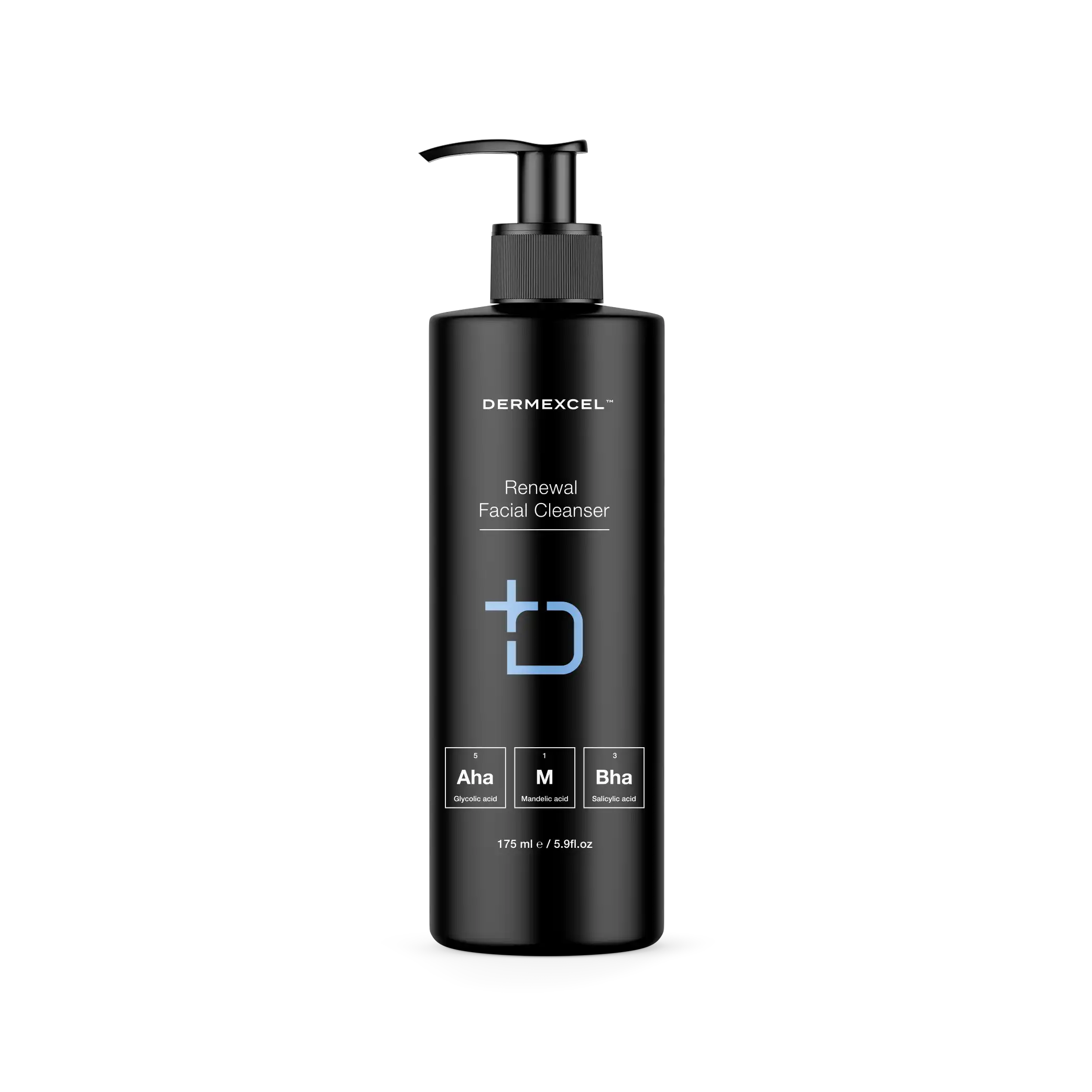
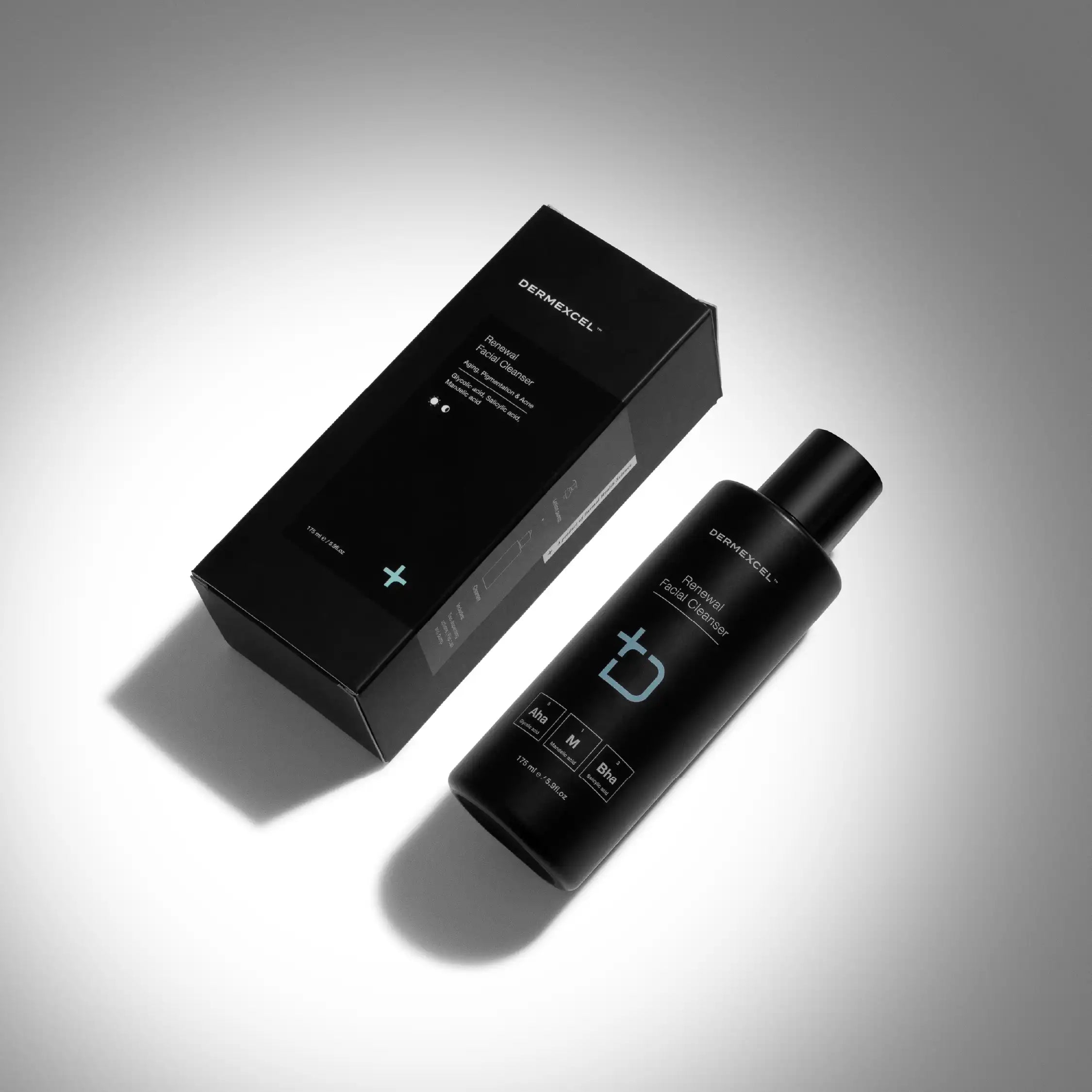
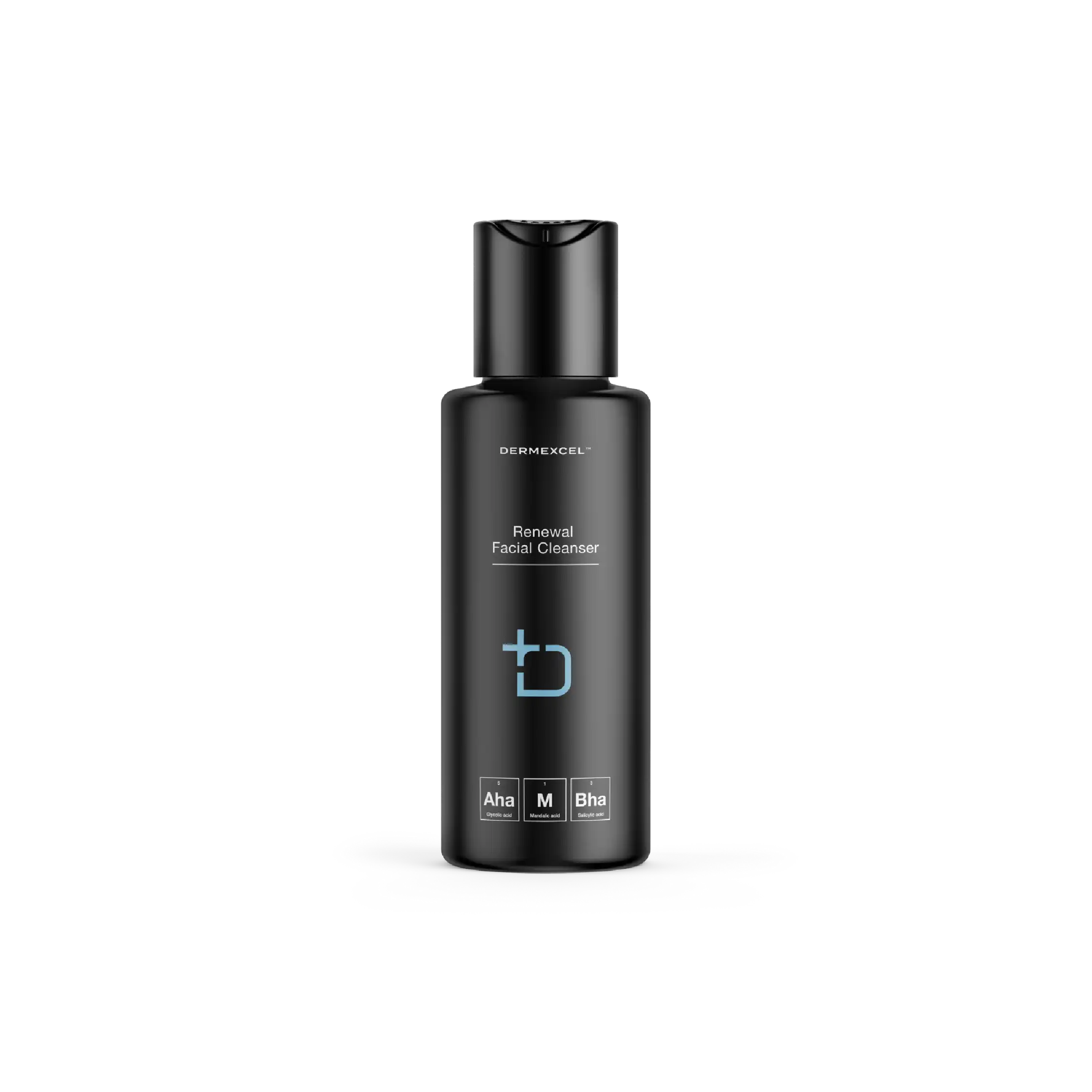





Unclog Pores

Minimize Pores

anti-aging

smooth skin

Brightening
This scientifically formulated treatment cleanser combats the detrimental effects of airborne bacteria and urban pollution on the skin. It leverages a potent blend of active ingredients to address common concerns such as skin aging, pigmentation, and inflammatory conditions. A gentle exfoliating action effectively removes dull, lifeless skin cells from the surface while simultaneously accelerating cell renewal at a deeper level. By doing so, it restores the skin's natural purity and radiance.
Renewal Facial Cleanser stands apart with its ability to address multiple skin concerns simultaneously. It removes impurities and pollutants from the skin's surface and dives deeper to stimulate cell renewal, resulting in a revitalized and healthier-looking complexion. With its scientifically backed formulation and carefully selected active ingredients, this cleanser offers an effective solution for those seeking to defend against environmental stressors and rejuvenate their skin.
Glycolic acid
Glycolic acid is highly acclaimed for its remarkable exfoliating and rejuvenating properties. Its small molecular size enables deep skin penetration, fostering efficient exfoliation at the cellular level.
Glycolic acid’s water solubility allows it to penetrate the upper layers of the skin easily. Its primary mechanism of action involves weakening the bonds between dead skin cells, promoting their shedding, and revealing the newer, healthier skin beneath. This process of accelerated cell turnover is instrumental in addressing a range of skin concerns, from aging signs like fine lines and wrinkles to texture irregularities and hyperpigmentation.
Glycolic acid's efficacy extends beyond mere exfoliation. It's also recognized for stimulating collagen production, a crucial protein in maintaining skin's elasticity and firmness. This aspect contributes to its anti-aging benefits. Furthermore, its hydrating properties add to its appeal, as they help increase the skin's capacity to retain moisture, leading to a more supple and vibrant complexion.
Clinical studies have consistently supported glycolic acid's role in improving skin appearance. Research indicates significant improvements in skin texture and pigmentation and the visible reduction of wrinkles and fine lines with glycolic acid.
Physiological Effects
- Exfoliation: Glycolic acid is a powerful exfoliant. It dissolves the bonds between dead skin cells on the skin’s surface, facilitating their removal and revealing newer, healthier skin underneath.
- Increased Collagen Production: It stimulates collagen production, essential for skin elasticity and firmness. This action helps reduce the appearance of fine lines and wrinkles.
- Enhanced Skin Hydration: Glycolic acid improves the skin's ability to retain moisture, enhancing hydration and a more plump, vibrant skin appearance.
- Skin Brightening: Removing dead skin cells can brighten the complexion and reduce the appearance of dark spots and hyperpigmentation.
- Improved Skin Texture: Regular use of glycolic acid can lead to smoother, more even textured skin, making it beneficial for conditions like keratosis pilaris.
- Acne Treatment: Its exfoliating properties help in unclogging pores, thereby reducing the occurrence of acne breakouts.
Managing Dermatological Conditions
- Aging Skin: Glycolic acid is widely used in anti-aging products to reduce signs of aging, such as fine lines, wrinkles, and age spots.
- Acne-Prone Skin: It helps manage acne by exfoliating the skin and removing blockage from pores.
- Hyperpigmentation: It effectively treats hyperpigmentation by accelerating the removal of hyperpigmented skin cells.
- Textural Irregularities: Glycolic acid improves skin texture, treating keratosis pilaris and other rough skin conditions.
- Sun-Damaged Skin: It helps rejuvenate sun-damaged skin by accelerating cell turnover and collagen synthesis.
References
- Bernstein, E. F. (2001). Glycolic acid treatment increases type I collagen mRNA and hyaluronic acid content of human skin. Dermatologic Surgery.
- Kornhauser, A., Coelho, S. G., & Hearing, V. J. (2010). Applications of hydroxy acids: classification, mechanisms, and photoactivity. Clinical, Cosmetic and Investigational Dermatology.
- Sharad, J. (2013). Glycolic acid peel therapy – a current review. Clinical, Cosmetic and Investigational Dermatology.
- Smith, W. P. (1996). Epidermal and dermal effects of topical lactic acid. Journal of the American Academy of Dermatology, 35(3), 388-391.
Mandelic acid
Despite its gentler nature, mandelic acid potently accelerates cell turnover, removes dead skin cells, and promotes a fresher, more rejuvenated skin appearance.
Mandelic acid's efficacy extends to a wide range of skin concerns. It's particularly beneficial in treating acne, as its antibacterial properties are effective against various strains of bacteria commonly associated with acne development. Moreover, it's known for regulating sebum production and reducing inflammation, further contributing to its acne-fighting capabilities.
Additionally, mandelic acid has shown promise in addressing hyperpigmentation. Its ability to inhibit melanin production helps reduce age spots, sun spots, and uneven skin tones, making it a valuable ingredient in skincare products targeting pigmentation issues. Studies have documented its effectiveness in improving skin texture and reducing the appearance of fine lines and wrinkles, offering a multifaceted approach to skin rejuvenation.
Physiological Effects
- Exfoliation: Mandelic acid gently exfoliates the skin by loosening the bonds between dead skin cells on the surface, promoting their removal and revealing fresh, new skin underneath.
- Antibacterial Properties: It possesses antibacterial properties, making it effective against acne-causing bacteria.
- Reducing Hyperpigmentation: Mandelic acid is known for its ability to reduce hyperpigmentation, including age spots, sun spots, and marks left by acne, due to its ability to inhibit melanin production.
- Anti-aging Effects: It stimulates collagen production, which can help reduce the appearance of fine lines and wrinkles and improve the overall texture of aging skin.
- Suitability for Sensitive Skin: Due to its larger molecular size than other AHAs, mandelic acid penetrates the skin more slowly and is less likely to irritate, making it suitable for sensitive skin types.
Managing Dermatological Conditions
- Acne Treatment: Its exfoliating and antibacterial properties make mandelic acid effective in treating acne, particularly in those with sensitive skin.
- Melasma and Hyperpigmentation: It is beneficial in treating melasma and other forms of hyperpigmentation, lightening dark spots without causing significant irritation.
- Aging Skin: Mandelic acid is used in anti-aging skin care products to improve skin texture and diminish signs of aging.
- Photo-Aging: It can help to reverse some of the damage caused by UV radiation, such as fine lines and uneven skin tone.
References
- Briden, M. E. (2004). Noninvasive treatments of acne. In Acne and its Therapy (pp. 341-357). Marcel Dekker.
- Taylor, M. B. (1999). Summary of mandelic acid for the improvement of skin conditions. Cosmetic Dermatology.
- Sharad, J. (2013). Glycolic acid peel therapy – a current review. Clinical, Cosmetic and Investigational Dermatology.
Salicylic acid
Salicylic acid, a renowned beta hydroxy acid (BHA), is a cornerstone in dermatology and skincare due to its exceptional keratolytic and comedolytic properties. Its unique ability to penetrate oil-laden hair follicle pores makes it particularly effective in treating acne-prone and oily skin types.
Salicylic acid dissolves skin debris (sebum and dead skin cells) that clogs pores and causes acne. It's a mild antibacterial and powerful anti-inflammatory agent that helps reduce the redness and swelling associated with breakouts.
What sets salicylic acid apart in dermatological treatments is its ability to exfoliate the skin, not just on the surface but within the pores themselves. This is due to its oil-soluble nature, which allows it to penetrate deep into the pores and dissolve the keratin plugs that lead to blackheads and whiteheads.
Furthermore, salicylic acid also has the capacity to adjust the pH of the skin, creating an environment less favorable for the growth of acne-causing bacteria. Salicylic acid's efficacy in treating various skin conditions, particularly acne, has been extensively documented in the scientific literature. Studies have consistently shown its ability to reduce acne lesions in terms of count and severity. Additionally, salicylic acid is highly recommended for its effectiveness in treating other skin conditions, such as psoriasis and dandruff, due to its ability to soften and remove scales and flakes from the skin.
Physiological Effects
- Keratolytic Action: Salicylic acid is known for its ability to exfoliate the skin by dissolving the intercellular 'glue' that holds skin cells together, helping to remove dead skin cells and unclog pores.
- Comedolytic Effect: It is particularly effective in reducing comedones (blackheads and whiteheads) by unclogging pores and preventing the formation of new comedones.
- Anti-inflammatory Properties: Salicylic acid reduces inflammation, which is beneficial in treating acne and other inflammatory skin conditions.
- Sebum Regulation: It helps to regulate oil production, making it a valuable ingredient for managing oily and acne-prone skin.
- Penetration Enhancement: Due to its lipophilic nature, it can penetrate sebum-filled follicles, effectively treating acne located deep within the pores.
Managing Dermatological Conditions
- Acne Vulgaris: Salicylic acid is a cornerstone in acne treatment, effectively preventing and treating existing acne lesions.
- Psoriasis: Its keratolytic properties make it helpful in softening and removing scales associated with psoriasis.
- Warts: Salicylic acid is commonly used to treat warts because it can exfoliate and remove thick skin.
- Seborrheic Dermatitis: It helps manage seborrheic dermatitis by reducing scaling and redness.
- Keratosis Pilaris: Salicylic acid can aid in smoothing the rough bumps associated with peratosis Pilaris.
References
- Zaenglein, A. L., Pathy, A. L., Schlosser, B. J., Alikhan, A., Baldwin, H. E., Berson, D. S., & Thiboutot, D. M. (2016). Guidelines of care for the management of acne vulgaris. Journal of the American Academy of Dermatology, 74(5), 945-973.e33.
- Kornhauser, A., Coelho, S. G., & Hearing, V. J. (2010). Applications of hydroxy acids: classification, mechanisms, and photoactivity. Clinical, cosmetic and investigational dermatology, 3, 135.
- Zander, E., & Weisman, S. (1992). Treatment of acne vulgaris with salicylic acid pads. Clinical Therapeutics.
- Gupta, A. K., & Nicol, K. (2004). The use of sulfur in dermatology. Journal of Drugs in Dermatology.

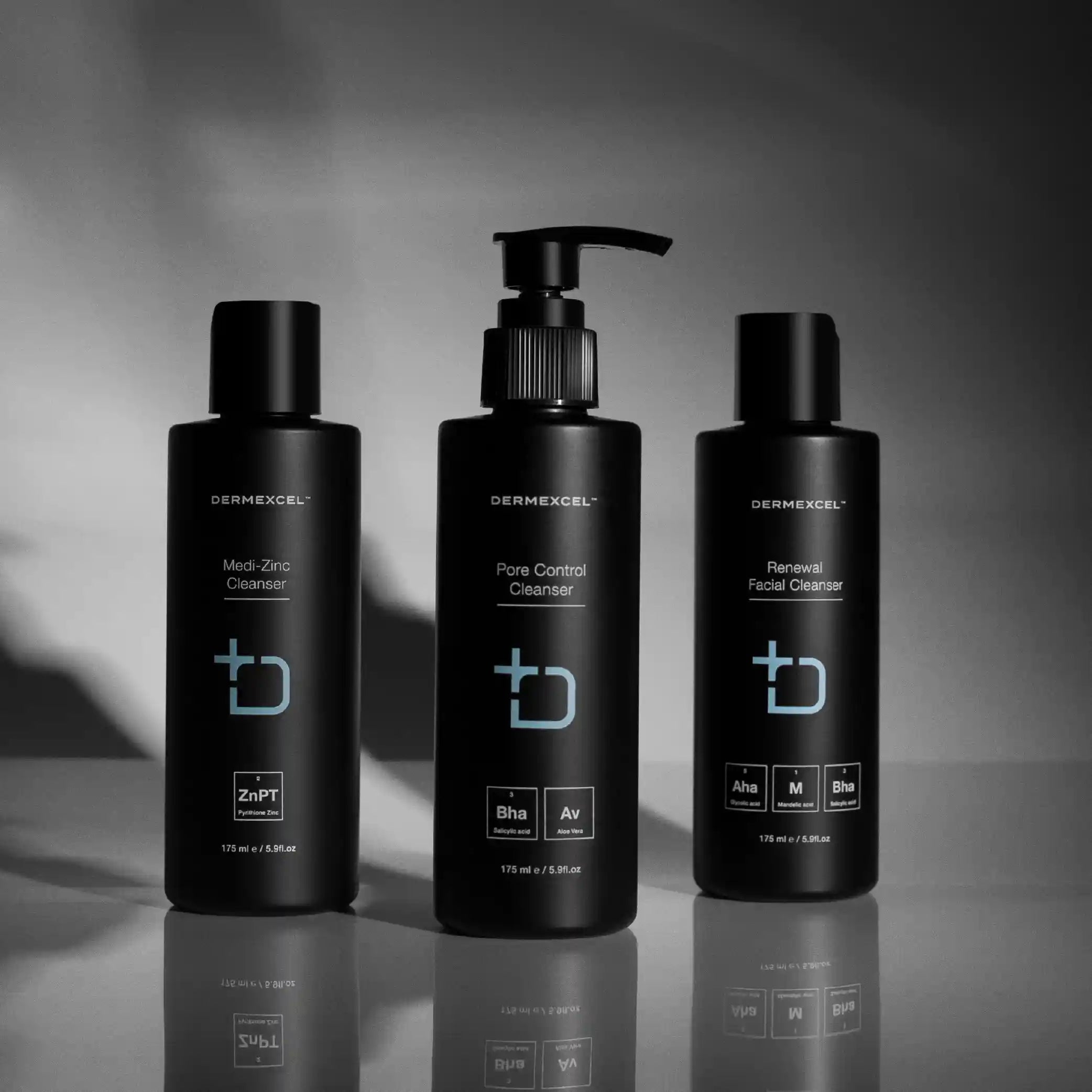
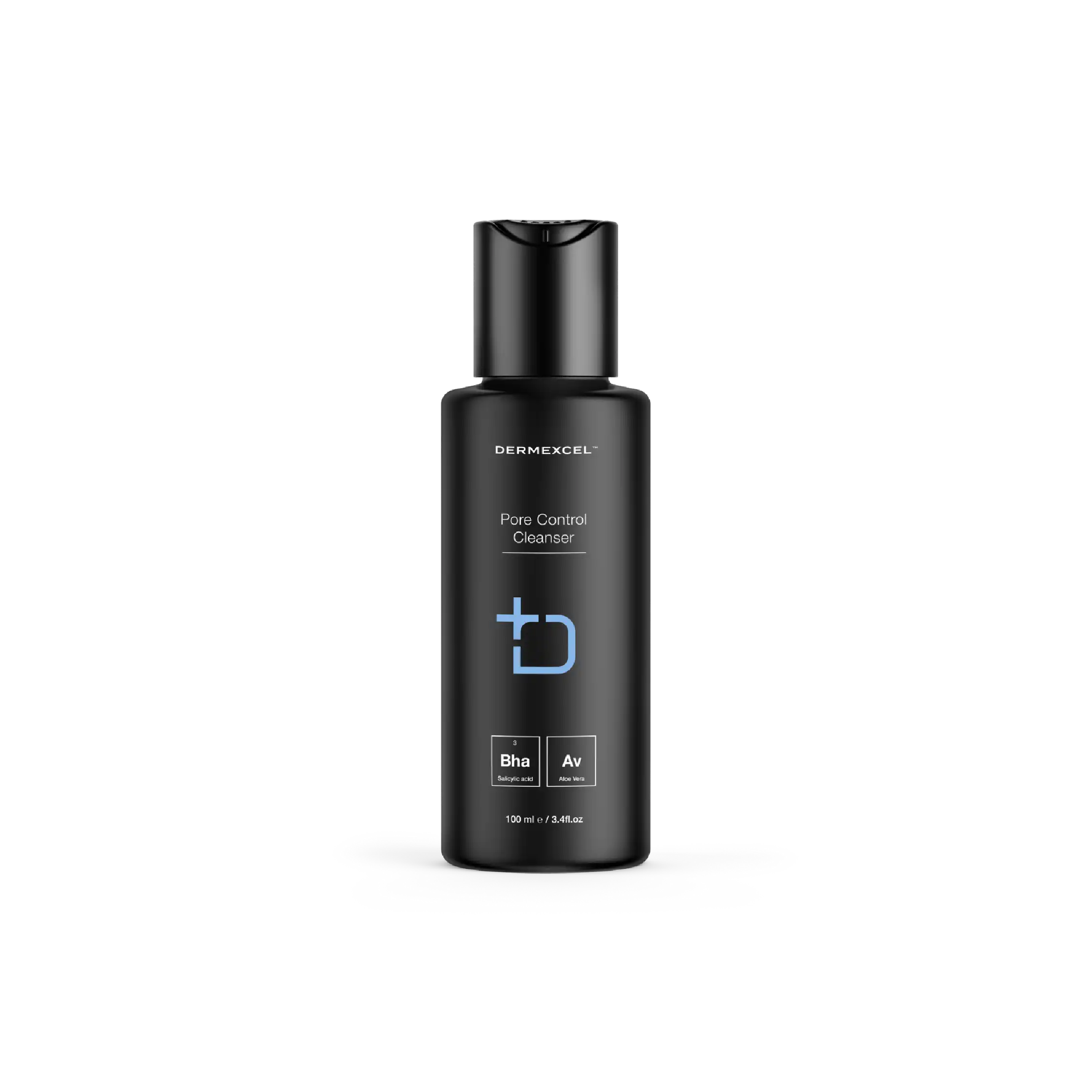





Unclog Pores

Minimize Pores

Anti-Acne

anti-redness

↓ inflammation
This scientifically formulated skincare solution regulates sebum production, thereby mitigating pore congestion. It employs a 3% concentration of Salicylic acid, a renowned anti-inflammatory agent, which diligently alleviates skin irritation and redness. This ingredient is also known for its potent anti-bacterial properties, effectively cleansing the skin of stubborn impurities.
A distinguishing feature of this cleanser is its inclusion of medical-grade Aloe Vera, a natural ingredient revered for its skin-nourishing capabilities. Aloe Vera imparts soothing and hydrating effects, particularly beneficial for skin dehydration due to other acne treatments.
Pore Control Cleanser is a balanced blend of scientifically proven ingredients that synergistically maintain skin health. It normalizes oil production, dislodges sebum plugs, reduces inflammation, and nourishes the skin, making it a comprehensive solution for maintaining a clear and healthy complexion.
Salicylic acid
Salicylic acid, a renowned beta hydroxy acid (BHA), is a cornerstone in dermatology and skincare due to its exceptional keratolytic and comedolytic properties. Its unique ability to penetrate oil-laden hair follicle pores makes it particularly effective in treating acne-prone and oily skin types.
Salicylic acid dissolves skin debris (sebum and dead skin cells) that clogs pores and causes acne. It's a mild antibacterial and powerful anti-inflammatory agent that helps reduce the redness and swelling associated with breakouts.
What sets salicylic acid apart in dermatological treatments is its ability to exfoliate the skin, not just on the surface but within the pores themselves. This is due to its oil-soluble nature, which allows it to penetrate deep into the pores and dissolve the keratin plugs that lead to blackheads and whiteheads.
Furthermore, salicylic acid also has the capacity to adjust the pH of the skin, creating an environment less favorable for the growth of acne-causing bacteria. Salicylic acid's efficacy in treating various skin conditions, particularly acne, has been extensively documented in the scientific literature. Studies have consistently shown its ability to reduce acne lesions in terms of count and severity. Additionally, salicylic acid is highly recommended for its effectiveness in treating other skin conditions, such as psoriasis and dandruff, due to its ability to soften and remove scales and flakes from the skin.
Physiological Effects
- Keratolytic Action: Salicylic acid is known for its ability to exfoliate the skin by dissolving the intercellular 'glue' that holds skin cells together, helping to remove dead skin cells and unclog pores.
- Comedolytic Effect: It is particularly effective in reducing comedones (blackheads and whiteheads) by unclogging pores and preventing the formation of new comedones.
- Anti-inflammatory Properties: Salicylic acid reduces inflammation, which is beneficial in treating acne and other inflammatory skin conditions.
- Sebum Regulation: It helps to regulate oil production, making it a valuable ingredient for managing oily and acne-prone skin.
- Penetration Enhancement: Due to its lipophilic nature, it can penetrate sebum-filled follicles, effectively treating acne located deep within the pores.
Managing Dermatological Conditions
- Acne Vulgaris: Salicylic acid is a cornerstone in acne treatment, effectively preventing and treating existing acne lesions.
- Psoriasis: Its keratolytic properties make it helpful in softening and removing scales associated with psoriasis.
- Warts: Salicylic acid is commonly used to treat warts because it can exfoliate and remove thick skin.
- Seborrheic Dermatitis: It helps manage seborrheic dermatitis by reducing scaling and redness.
- Keratosis Pilaris: Salicylic acid can aid in smoothing the rough bumps associated with peratosis Pilaris.
References
- Zaenglein, A. L., Pathy, A. L., Schlosser, B. J., Alikhan, A., Baldwin, H. E., Berson, D. S., & Thiboutot, D. M. (2016). Guidelines of care for the management of acne vulgaris. Journal of the American Academy of Dermatology, 74(5), 945-973.e33.
- Kornhauser, A., Coelho, S. G., & Hearing, V. J. (2010). Applications of hydroxy acids: classification, mechanisms, and photoactivity. Clinical, cosmetic and investigational dermatology, 3, 135.
- Zander, E., & Weisman, S. (1992). Treatment of acne vulgaris with salicylic acid pads. Clinical Therapeutics.
- Gupta, A. K., & Nicol, K. (2004). The use of sulfur in dermatology. Journal of Drugs in Dermatology.
Aloe Vera
Aloe vera is well-regarded for its medicinal applications and has been a staple in skincare and health for centuries. It’s rich in vitamins, enzymes, minerals, and amino acids, contributing to its many skin benefits.
Aloe vera contains polysaccharides, which are crucial in its moisturizing and anti-inflammatory properties. These polysaccharides help bind moisture to the skin, making aloe vera an excellent hydrating agent for dry and damaged skin.
One of the key benefits of aloe vera is its soothing and healing properties, particularly beneficial for burns, abrasions, and skin irritations. It has been shown to accelerate the healing of minor burns and reduce skin inflammation. Various studies have supported its effectiveness in treating first- and second-degree burns, highlighting its role in enhancing collagen synthesis and skin regeneration.
Aloe vera's anti-inflammatory properties are attributed to compounds like glycoproteins and polysaccharides. These compounds help reduce pain and swelling associated with skin irritations and wounds. Aloe vera also contains aloin and emodin, which provide analgesic, antibacterial, and antiviral properties, further extending its therapeutic potential.
Aloe Vera has numerous physiological effects on the skin due to its rich composition of vitamins, enzymes, minerals, and amino acids. The presence of antioxidants such as vitamins C and E, along with beta-carotene, contributes to its anti-aging benefits, helping to improve skin firmness and keep the skin hydrated.
Physiological Effects
- Moisturizing and Hydrating: Aloe Vera enhances skin hydration, making it effective for dry and dehydrated skin. Its mucopolysaccharides help to bind moisture into the skin.
- Wound Healing: It accelerates wound healing by enhancing collagen synthesis and cross-linking. This effect is particularly useful in healing burns, abrasions, and cuts.
- Anti-inflammatory Properties: Aloe Vera contains compounds like aloin and anthraquinones that have anti-inflammatory properties, making it beneficial in reducing skin inflammation.
- Antimicrobial Activity: It possesses antimicrobial properties, which help in preventing infections in wounds and burns.
- Antioxidant Properties: The presence of vitamins C and E and beta-carotene provides it with antioxidant properties, which can help protect the skin from free radical damage.
- Soothing Effect: Aloe Vera is known for its soothing effects on the skin, particularly in conditions like sunburn.
Managing Dermatological Conditions
- Burns and Wound Care: Aloe Vera's wound-healing and soothing properties make it effective in treating burns, including sunburns and minor skin abrasions.
- Acne Treatment: Due to its antimicrobial and anti-inflammatory properties, it can help treat acne.
- Eczema and Psoriasis: Its moisturizing, anti-inflammatory, and soothing properties are beneficial in managing symptoms of eczema and psoriasis.
- Aging Skin: Aloe Vera's antioxidant properties and ability to improve collagen production can help reduce the signs of aging.
- Skin Hydration: It's a common ingredient in moisturizers and other skin care products for its hydrating properties.
References
- Surjushe, A., Vasani, R., & Saple, D. G. (2008). Aloe vera: A short review. Indian Journal of Dermatology.
- Maenthaisong, R., Chaiyakunapruk, N., Niruntraporn, S., & Kongkaew, C. (2007). The efficacy of aloe vera used for burn wound healing: A systematic review. Burns.
- Rajeswari, R., Umadevi, M., Rahale, C. S., Pushpa, R., Selvavenkadesh, S., Kumar, K. S., & Bhowmik, D. (2012). Aloe vera: The miracle plant its medicinal and traditional uses in India. Journal of Pharmacognosy and Phytochemistry.
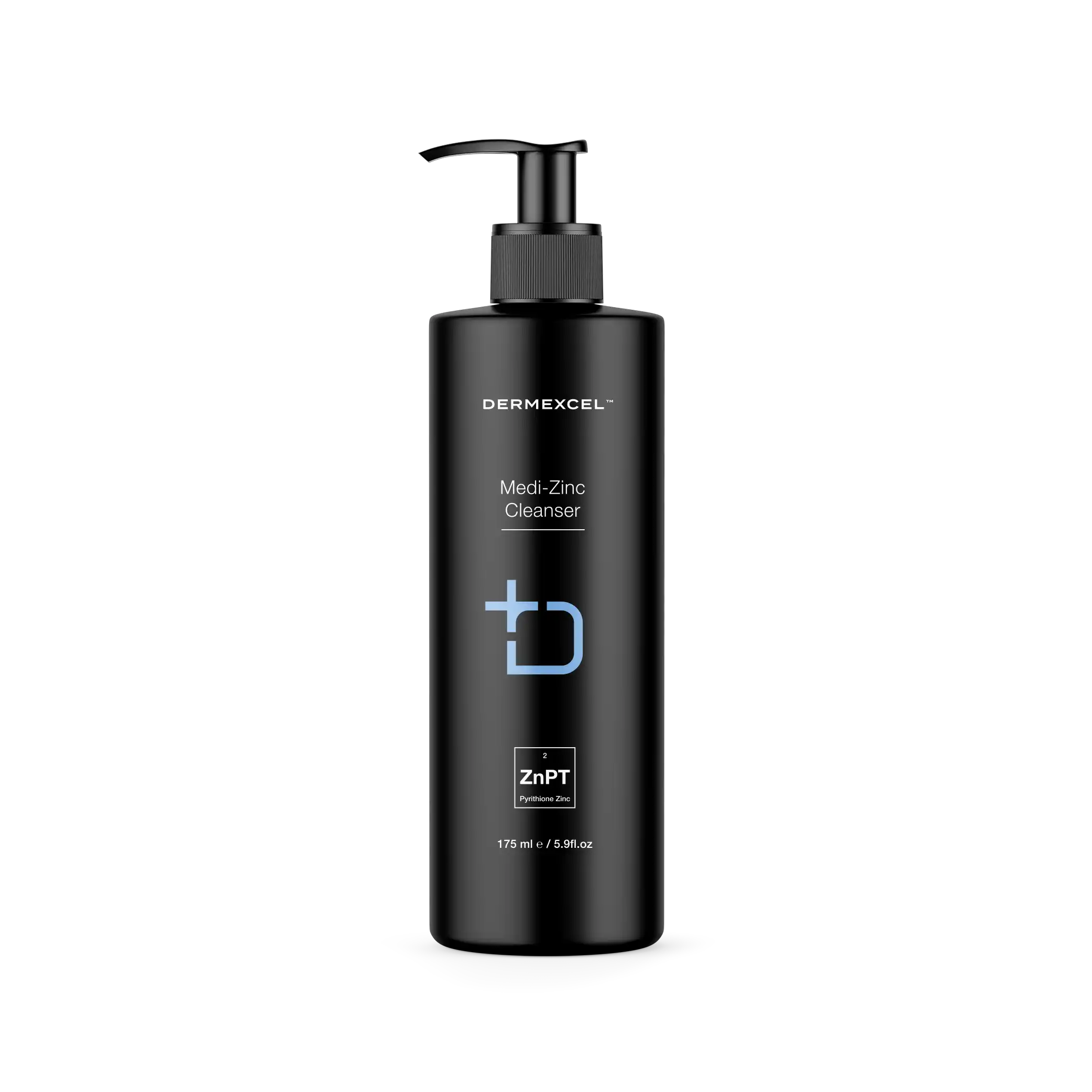
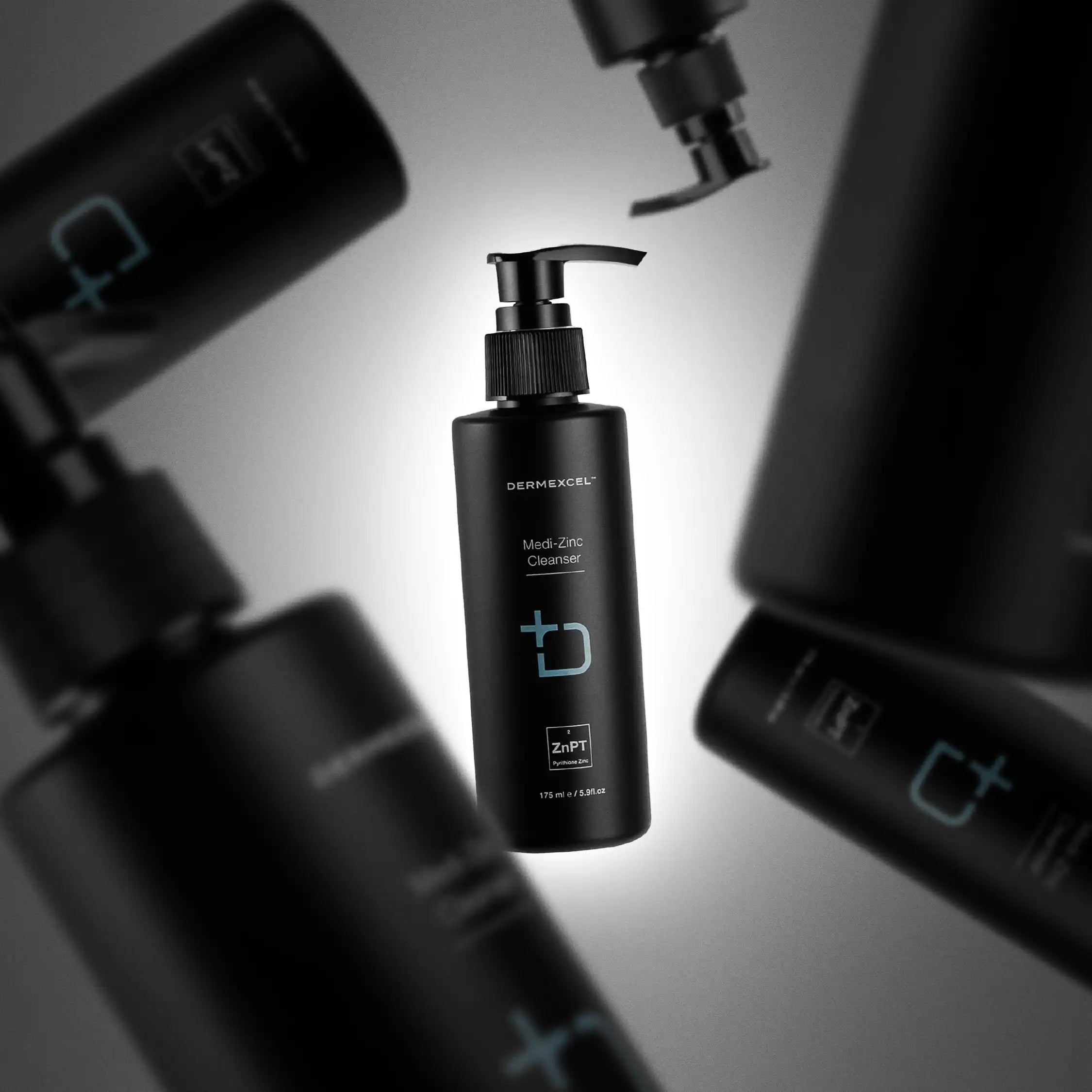
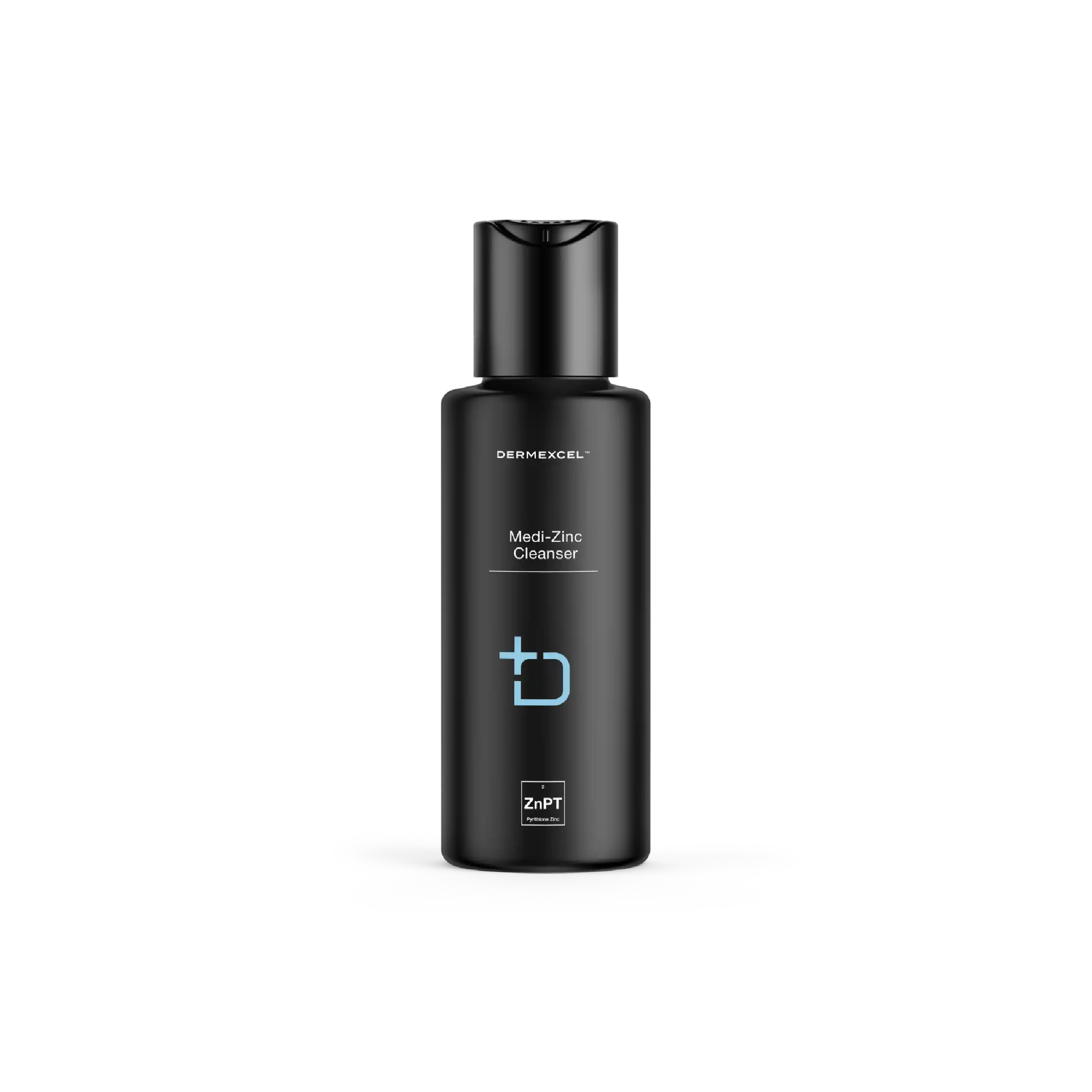





Itch Relief

Anti-Acne

↓ inflammation

anti-redness

Anti-microbial
A powerful hypoallergenic medicated solution with beneficial properties attributed to its active constituent, Zinc Pyrithione. This chemical compound, FDA-approved and clinically recognized, delivers strong antibacterial and antifungal action, making the cleanser an ideal choice for managing skin conditions associated with redness, flaking, irritation, and itching.
Zinc Pyrithione's efficacy, compounded by a gentle cleansing base, facilitates the lifting and removing of impurities, leaving the complexion refreshed. Concurrently, it sustains a tranquil skin environment, reducing inflammation and discomfort. As a daily cleansing aid, Medi-Zinc Cleanser proposes a reliable, scientifically-backed intervention in fostering skin health and comfort.
Zinc Pyrithione
Zinc pyrithione, a compound with potent antifungal and antibacterial properties, has established itself as a cornerstone in the treatment of various skin conditions, particularly those involving Malassezia yeast. Its effectiveness against seborrheic dermatitis and dandruff, which are often associated with an overgrowth of Malassezia species, makes it a key ingredient for many dermatological conditions.
Zinc pyrithione’s mode of action is multifaceted, primarily targeting the membrane of fungi and bacteria, thereby disrupting their growth and replication. One of its significant mechanisms involves inhibiting fungal cell membrane transport by blocking the energy production pathway, which is crucial for cell survival.
In Malassezia, yeast, a natural inhabitant of the skin flora, can overgrow and cause conditions like seborrheic dermatitis and dandruff; zinc pyrithione's antifungal action is particularly beneficial. It reduces the yeast population on the skin, thereby alleviating the symptoms associated with its overgrowth, such as flaking, irritation, and redness.
Its efficacy in treating seborrheic dermatitis is attributed to its ability to reduce the Malassezia count, diminish inflammatory responses, and soothe the skin. Similarly, in dandruff, which is often linked to an excess of Malassezia, zinc pyrithione effectively reduces flaking and itchiness, promoting a healthier scalp environment.
The efficacy of zinc pyrithione in the treatment of seborrheic dermatitis and dandruff is well-documented. Its safety profile and efficacy have been confirmed by numerous studies, with significant improvements observed in both scalp and skin conditions following regular use.
Physiological Effects
- Antifungal Activity: It is effective against a range of fungi, including those that cause dandruff and seborrheic dermatitis. Zinc Pyrithione inhibits the division of fungal cells, reducing their proliferation.
- Antibacterial Properties: This compound also exhibits antibacterial activity, making it useful in treating and preventing bacterial skin infections.
- Anti-inflammatory Effects: Zinc Pyrithione can reduce inflammation, which is beneficial in alleviating symptoms of various inflammatory skin conditions.
- Sebum Regulation: It helps in regulating sebum production, which can be beneficial for oily skin and conditions like acne.
Managing Dermatological Conditions
- Dandruff and Seborrheic Dermatitis: Zinc Pyrithione is a common ingredient in anti-dandruff shampoos and is effective in controlling the flaking and itching associated with these conditions.
- Psoriasis: It can help manage the symptoms of psoriasis, particularly in reducing scaling and redness.
- Acne: Due to its antibacterial and anti-inflammatory properties, Zinc Pyrithione can be beneficial in the treatment of acne.
- Fungal Infections: It is effective in treating various fungal skin infections due to its antifungal properties.
References
- Warshaw, E. M., et al. (2005). Efficacy of Zinc Pyrithione in Seborrheic Dermatitis and Dandruff. Dermatology.
- Pierard-Franchimont, C., et al. (2002). Antidandruff shampoo efficacy in dandruff/seborrhoeic dermatitis. International Journal of Cosmetic Science.
- Scheman, A., et al. (2000). Antimicrobial Activity of Zinc Pyrithione. American Journal of Infection Control.
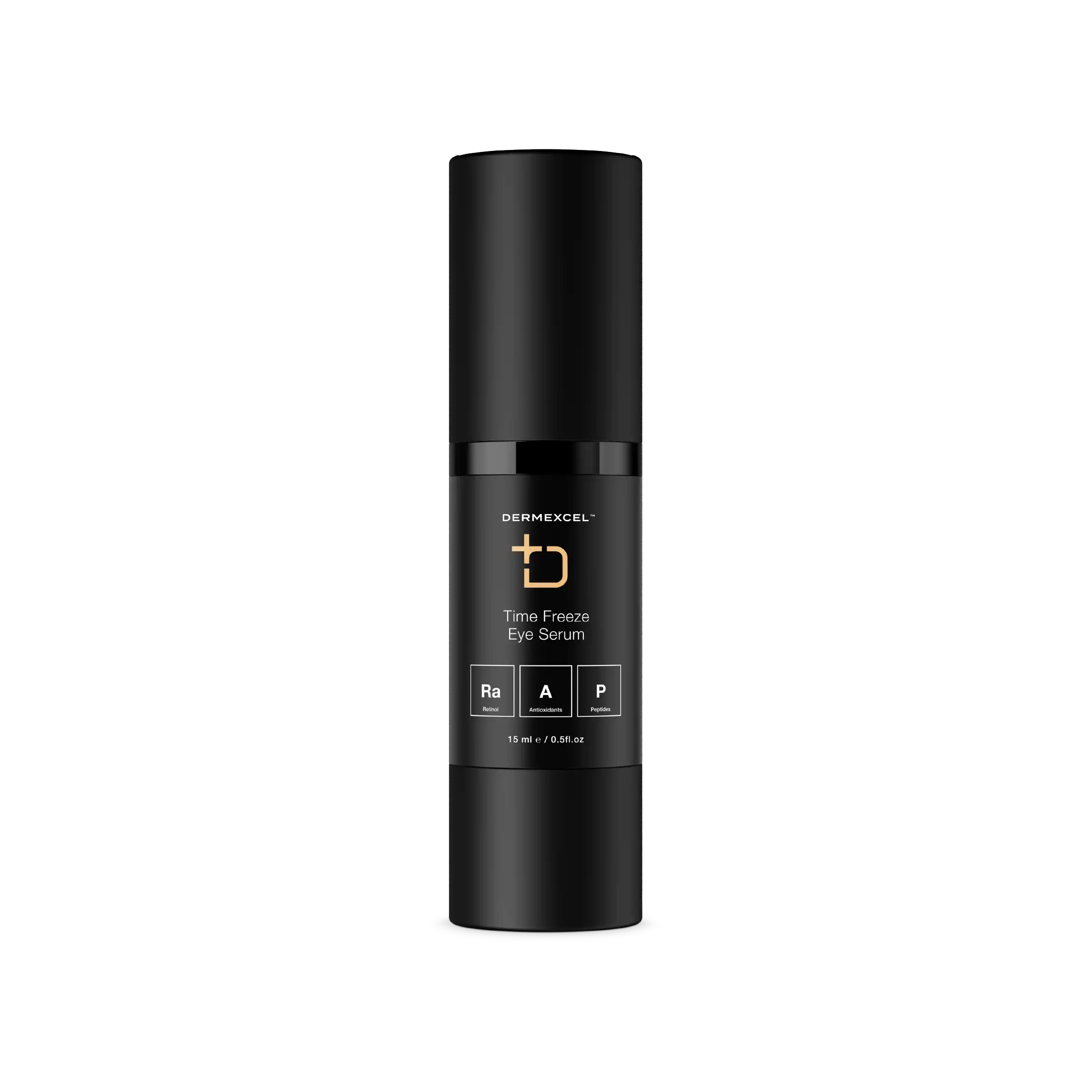
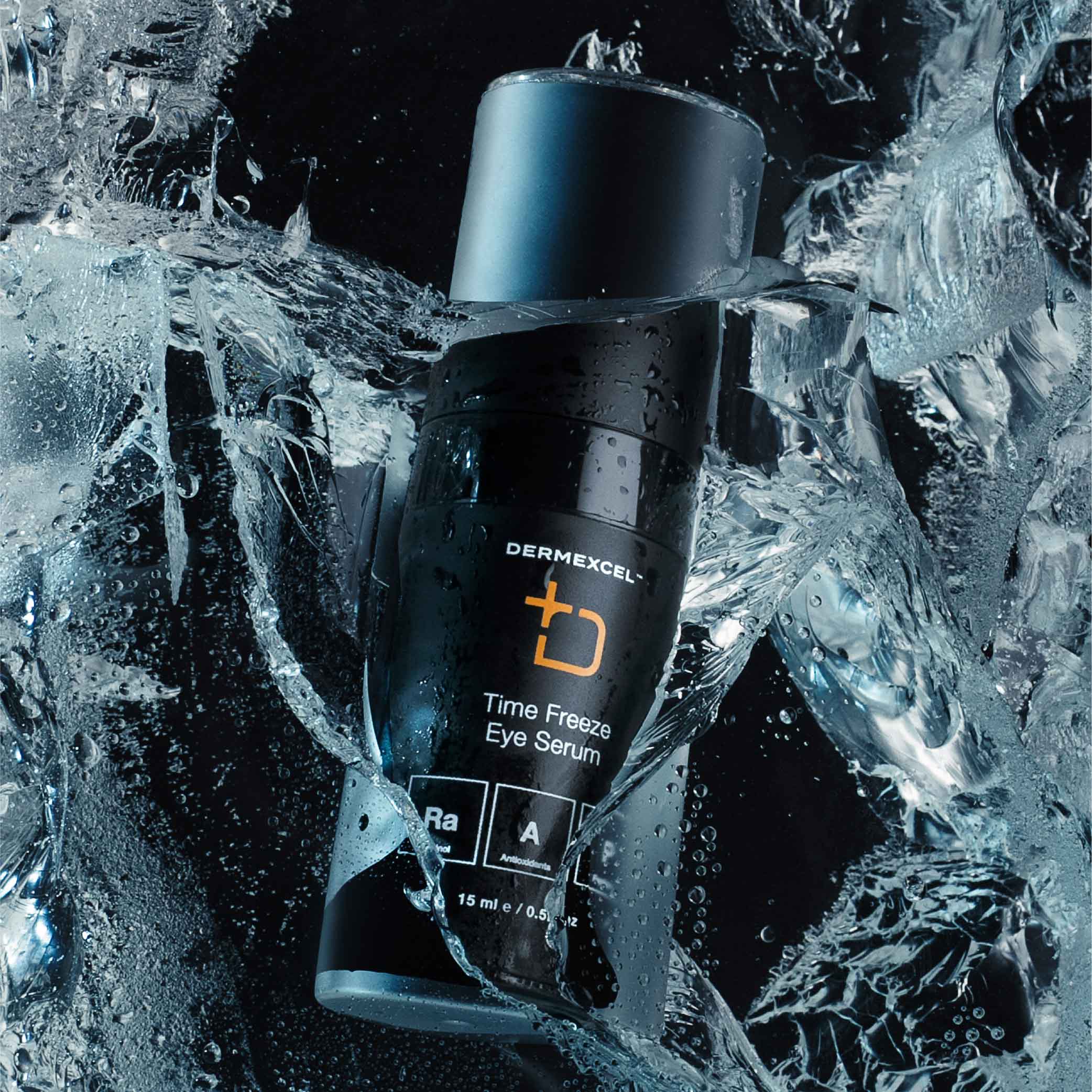




SIZE: 15 mL

Anti-Aging

Antioxidant

Moisturizing

Firming

↑ Elasticity
Time Freeze Eye Serum is a potent firming formulation specifically designed to ameliorate concerns of lines, wrinkles, puffiness, and sagging skin beneath the eyes. The serum tightens the skin upon application and has a long-lasting impact, significantly contributing to an uplifted and defined face contour.
Its power derives from key ingredients such as Acetyl Hexapeptide-8, known for its ability to reduce the appearance of wrinkles by inhibiting neural signals that cause facial muscles to tense, indirectly leading to a smoother skin surface. Bioskinup Contour™, a blend of botanical extracts, offers anti-edema properties that mitigate puffiness.
Retinol, specifically in the form of Hydroxypinacolone Retinoate, a less irritating retinoid, facilitates cellular renewal, aiding the skin in appearing firm and reducing the visibility of age-related changes. Furthermore, antioxidants, such as Tocopherol (Vitamin E), guard against harmful free radicals, fostering the resilience of the skin.
The formulation is scientifically balanced, ensuring optimal absorption and maximum efficacy without compromising skin health. Time Freeze Eye Serum is rooted in robust science, leveraging bioactive compounds to enhance the skin's overall texture and appearance.
Acetyl Hexapeptide-8
Acetyl Hexapeptide-8: The Innovative Peptide in Anti-Aging Dermatology
Acetyl Hexapeptide-8 is a testament to the advancements in peptide technology in dermatology. Its ability to reduce facial muscle contractions non-invasively positions it as an essential ingredient in anti-aging skincare.
Biochemical Mechanism
Acetyl Hexapeptide-8 functions by inhibiting the neurotransmitters that trigger muscle contractions. This action reduces the intensity of wrinkle-causing facial expressions, leading to a visible decrease in fine lines and wrinkles. It mimics the N-terminal end of SNAP-25, competing with this natural protein for a position in the SNARE complex, thereby destabilizing it. As a result, neurotransmitter release is diminished, and facial muscle contractions are softened.
Physiological Effects
- Neurotransmitter Inhibition: Acetyl Hexapeptide-8 works by inhibiting neurotransmitter release. This leads to reduced facial muscle contraction, a mechanism similar to Botox but less invasive.
- Reduction of Expression Lines: Helps to reduce the appearance of expression lines, particularly around the forehead and eyes, by limiting muscle contraction.
- Improvement in Skin Texture: Regular use can lead to smoother skin texture and a reduction in the depth and severity of wrinkles.
Special Benefits
Clinical Efficacy - Clinical studies have demonstrated the effectiveness of Acetyl Hexapeptide-8 in reducing wrinkle depth. A study published in the "International Journal of Cosmetic Science" reported that a cream containing 10% Acetyl Hexapeptide-8 reduced wrinkles by 30% over 30 days (Blanes-Mira et al., 2002).
References
- Blanes-Mira, C., et al. (2002). A synthetic hexapeptide (Argireline) with antiwrinkle activity. International Journal of Cosmetic Science.
- Wang, Y., et al. (2013). The anti-wrinkle efficacy of Argireline. Journal of Cosmetic and Laser Therapy.
- Ruiz, M. A., et al. (2007). New cosmetic formulations containing Argireline. Journal of Cosmetic Science.
Vitamin E
The fat-soluble Vitamin E's benefits in maintaining skin health and appearance are well-acknowledged in both cosmetic and clinical dermatology. Comprising a group of eight compounds, including four tocopherols and four tocotrienols, Vitamin E is known for its role in protecting cell membranes from oxidative damage.
Vitamin E is celebrated in skincare for its ability to neutralize free radicals caused by environmental stressors such as UV radiation and pollution. These free radicals can lead to premature skin aging, making Vitamin E a valuable ingredient in anti-aging skincare products. Its antioxidant action helps to protect the skin from damage, reduce the appearance of wrinkles, and improve skin texture and tone.
Additionally, Vitamin E is known for its moisturizing benefits. It helps to strengthen the skin barrier, reduce moisture loss, and keep the skin hydrated and supple. This makes it especially beneficial for dry and damaged skin.
Vitamin E also has anti-inflammatory properties, making it beneficial in soothing and calming irritated skin. This has implications for conditions such as dermatitis and acne, where inflammation plays a key role.
Physiological Effects
- Antioxidant Protection: Vitamin E neutralizes harmful free radicals in the skin, preventing oxidative stress and damage caused by environmental factors like UV radiation and pollution.
- Moisturization: It has moisturizing properties, helping to improve skin hydration and alleviate dryness.
- Wound Healing: Vitamin E may assist in the skin's healing process, although its efficacy in wound healing is still a subject of research.
- Photoprotection: While not a sunscreen, it can provide some degree of photoprotection by strengthening the skin's defense against UV-induced damage.
- Anti-Inflammatory Effects: It helps reduce skin inflammation and is beneficial in managing conditions like eczema and psoriasis.
Managing Dermatological Conditions
- Skin Aging: Its antioxidant properties make it useful in anti-aging skincare products to protect against free radical damage and improve skin appearance.
- Dry Skin Conditions: Vitamin E's moisturizing effects are beneficial in treating dry skin and improving overall skin texture.
- Inflammatory Skin Diseases: It can be helpful in soothing inflammatory skin conditions like eczema and psoriasis.
- Sun Protection and Repair: Vitamin E is included in sunscreens and after-sun products for its ability to mitigate sun damage.
- Scar Treatment: Some studies suggest Vitamin E may help reduce the appearance of scars, although evidence is mixed.
References
- Thiele, J. J., Hsieh, S. N., & Ekanayake-Mudiyanselage, S. (1998). Vitamin E: Critical Review of Its Current Use in Cosmetic and Clinical Dermatology. Dermatologic Surgery, 24(7), 805–813.
- Ratz-Łyko, A., & Arct, J. (2016). Anti-inflammatory and anti-aging properties of active skin care ingredients. Journal of Clinical and Aesthetic Dermatology, 9(9), 36–40.
- Keen, M. A., & Hassan, I. (2016). Vitamin E in dermatology. Indian Dermatology Online Journal.
- Ekanayake-Mudiyanselage, S., & Thiele, J. (2007). Vitamin E in human skin: Organ-specific physiology and considerations for its use in dermatology. Molecular Aspects of Medicine.
- Nachbar, F., & Korting, H. C. (1995). The role of vitamin E in normal and damaged skin. Journal of Molecular Medicine.
Peptides
Peptides are short chains of amino acids with a wide range of biological functions and skin benefits. They are essentially small fragments of proteins, which are fundamental components of all living cells, including collagen and elastin in the skin.
In skincare, peptides are known for enhancing skin repair and rejuvenation. They function as signaling molecules, instructing cells to perform specific tasks such as producing collagen and elastin, vital for maintaining the skin's firmness and elasticity. This makes peptides especially beneficial in anti-aging products, as they can help reduce the appearance of fine lines and wrinkles.
Research has shown that certain peptides can improve skin barrier function, increase hydration, and soothe skin inflammation. This makes them suitable for products targeting dry, sensitive, or inflamed skin.
Peptides, with their diverse functions in promoting collagen production, strengthening the skin barrier, wound healing, and anti-inflammatory actions, are pivotal in managing various dermatological conditions, particularly in anti-aging, sensitive skin care, and wound healing applications.
Physiological Effects
- Collagen Production: Certain peptides, known as signal peptides, stimulate collagen production in the skin, enhancing skin firmness and reducing the appearance of fine lines and wrinkles.
- Skin Barrier Strengthening: Peptides can strengthen the skin barrier, improve hydration, and protect against environmental damage.
- Wound Healing: Some peptides play a role in the skin's natural healing process, aiding tissue repair and regeneration.
- Anti-Inflammatory Effects: Certain peptides have anti-inflammatory properties, helping to soothe and calm irritated skin.
- Antimicrobial Action: Some peptides possess antimicrobial properties, potentially helping to manage acne and other skin infections.
Managing Dermatological Conditions
- Aging Skin: Peptides can stimulate collagen production and improve skin elasticity.
- Sensitive Skin Conditions: Peptides are beneficial for sensitive or inflamed skin due to their soothing properties.
- Acne-Prone Skin: Antimicrobial peptides can be effective in acne treatment formulations.
- Wound Care and Repair: Peptides improve wound healing and reduce scarring.
References
- Gorouhi, F., & Maibach, H. I. (2009). Role of topical peptides in preventing or treating aged skin. International Journal of Cosmetic Science.
- Schagen, S. K. (2012). Topical peptide treatments with effective anti-aging results. Cosmetics.
- Varani, J., et al. (2001). Vitamin A antagonizes decreased cell growth and elevated collagen-degrading matrix metalloproteinases and stimulates collagen accumulation in naturally aged human skin. Journal of Investigative Dermatology.
Retinoic acid analogue
Retinoic acid, often referred to as tretinoin in its pharmaceutical form, is the active form of Vitamin A. It is widely recognized for its powerful effects in dermatology and skin care, particularly in treating acne and signs of skin aging.
Retinoic acid works at the cellular level to modify gene expression and affect cell growth. In treating acne, it promotes the turnover of skin cells, reducing the likelihood of pore-clogging and helping to clear existing breakouts. Additionally, it decreases the cohesiveness of follicular epithelial cells, further preventing the formation of comedones.
Retinoic acid's ability to stimulate collagen production is a key benefit in anti-aging skincare. This leads to a reduction in fine lines and wrinkles and an improvement in overall skin texture and tone. It also aids skin discoloration and hyperpigmentation by accelerating cell turnover, bringing new skin cells to the surface faster, and shedding pigmented and damaged cells.
Despite its benefits, retinoic acid can irritate the skin, causing side effects like redness, dryness, and peeling, especially during the initial period of use. Its potency means it is generally available by prescription and requires careful monitoring by a healthcare professional.
Hydroxypinacolone Retinoate (HPR) is a newer, esterified form of retinoic acid. Unlike cosmetic retinol, HPR binds directly to the retinoid receptors of the skin cells without needing conversion. This direct binding allows it to deliver similar benefits to retinoic acid, such as stimulating collagen production, improving skin elasticity, and reducing signs of aging, but with a lower risk of irritation.
HPR is considered more gentle and less irritating than traditional retinoic acid while offering comparable benefits. With HPR, everyone has access to the benefits of prescription retinoids without the risk of side effects.
Physiological Effects
- Cell Turnover and Renewal: HPR promotes rapid cell turnover, aiding in the exfoliation of dead skin cells and generating new cells.
- Skin Texture: Promoting cell renewal improves skin texture and addresses issues like roughness and dullness.
- Collagen Production: It stimulates collagen production, which is essential for reducing the appearance of fine lines and wrinkles and improving skin elasticity.
- Acne Treatment: Effective in treating acne by unclogging pores and reducing the size of sebaceous glands, it diminishes both inflammatory and non-inflammatory acne lesions.
- Pigmentation: It can reduce hyperpigmentation by accelerating the turnover of hyperpigmented skin cells and inhibiting melanin production.
- Photoaging: Effective in treating signs of photoaging, reversing some of the damage caused by UV radiation.
Special Benefits
- Retinoid Receptor Activity: HPR, an ester of retinoic acid, binds directly to retinoid receptors in the skin, enabling it to work without needing to be converted into retinoic acid.
- Lower Irritation: Typically, it causes less irritation than retinoic acid, making it more suitable for sensitive skin types.
- Collagen Stimulation and Anti-Aging: Like retinoic acid, HPR helps in stimulating collagen production and has anti-aging properties.
- Acne and Hyperpigmentation: It effectively treats acne and reduces hyperpigmentation, often with fewer side effects than retinoic acid.
- Stability and Penetration: HPR is more stable and lipid-soluble, so it penetrates the skin more effectively and is less prone to degradation.
References
- Zaenglein, A. L., Pathy, A. L., Schlosser, B. J., Alikhan, A., Baldwin, H. E., Berson, D. S., ... & Thiboutot, D. M. (2016). Guidelines of care for the management of acne vulgaris. Journal of the American Academy of Dermatology, 74(5), 945-973.e33.
- Fisher, G. J., Wang, Z. Q., Datta, S. C., Varani, J., Kang, S., & Voorhees, J. J. (1996). Pathophysiology of premature skin aging induced by ultraviolet light. New England Journal of Medicine, 337(20), 1419-1428.
- Truchuelo, M. T., Jiménez, N., Jaén, P. (2018). Assessment of the efficacy of a new complex-based retinoic acid and retinol in a 3-month study using objective methods and skin biomarker analysis. Journal of Cosmetic Dermatology, 17(3), 347-354.
- Mukherjee, S., et al. (2006). Retinoids in the treatment of skin aging: an overview of clinical efficacy and safety. Clinical Interventions in Aging.
- Randhawa, M., et al. (2015). Hydroxypinacolone retinoate: a new retinoid and its use in dermatology. Skin Therapy Letter.
Bioskinup Contour
Bioskinup Contour 3R demonstrates a comprehensive mechanism of action targeting periorbital puffiness and dark circles. It stimulates collagen and elastin production, enhancing skin firmness and vascular wall resistance.
Clinical studies highlight its ability to maintain skin health under UV radiation, suggesting adaptogenic properties. In vivo evaluations reveal significant improvements in skin and ocular acceptability, with reductions in puffiness, dark circles, and under-eye bags. Instrumental assessments confirm its efficacy in enhancing microcirculation and skin tone, validating its dermatocosmetic benefits for the eye area.

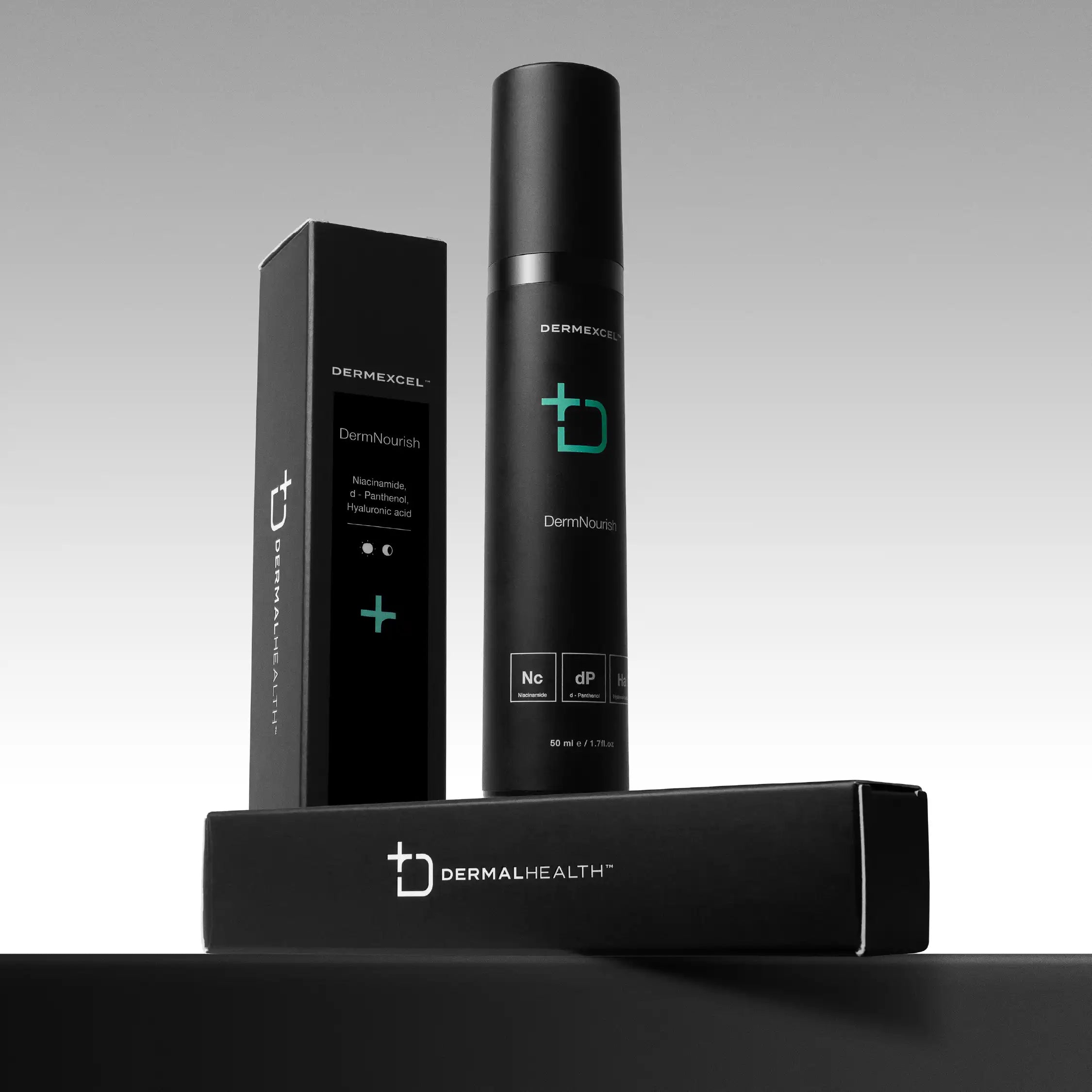




SIZE: 50 mL

barrier repair

↑ Elasticity

anti-aging

Moisturizing

↓ inflammation
DermNourish™, a meticulously crafted formula, aids in hydrating parched, sensitive, or impaired skin, replenishing much-needed moisture. It provides a robust shield, fortifying skin's barrier function and alleviating the discomfort of dry, distressed, and post-procedural skin.
Non-acnegenic, free from fragrances and colorants, DermNourish™ aims to minimize potential irritations and contact dermatitis. Key components include DuraQuench™ IQ SA and Niacinamide, both beneficial for skin's moisture retention and barrier fortification, and D-Panthenol, which soothes skin. Tocopherol, an antioxidant, protects against environmental stressors, while Sodium Hyaluronate bolsters skin hydration. DermNourish™ represents an advanced skin nourishment approach.
Hyaluronic acid
Hyaluronic acid (HA) is a naturally occurring glycosaminoglycan found throughout the body's connective, epithelial, and neural tissues. Most abundantly present in the skin, eyes, and synovial fluid, HA is renowned for its exceptional capacity to retain moisture — a single gram can hold up to six liters of water.
In skincare, the primary appeal of hyaluronic acid lies in its unparalleled hydrating abilities. As a humectant, HA attracts and retains moisture from the environment, providing intense hydration to the skin. This hydrating property contributes significantly to maintaining skin plumpness, suppleness, and elasticity.
Beyond hydration, hyaluronic acid also plays a vital role in skin repair and regeneration. It supports the skin's healing and repair processes, and its anti-inflammatory properties help calm irritated skin. Moreover, HA's ability to promote collagen production, a crucial protein for skin elasticity, further underscores its anti-aging benefits.
The molecular size of hyaluronic acid influences its skin penetration and efficacy. High-molecular-weight HA remains on the skin's surface, providing hydration and forming a barrier against moisture loss. In contrast, low-molecular-weight HA penetrates deeper into the skin's layers, offering more profound hydrating and rejuvenating effects.
Hyaluronic acid's remarkable ability to hydrate, improve skin elasticity, aid in wound healing, and provide antioxidant protection makes it valuable in managing various dermatological conditions, particularly aging, dryness, and sensitive skin.
Physiological Effects
- Hydration: Hyaluronic acid is a powerful humectant that can hold up to 1000 times its weight in water, significantly enhancing skin hydration and leading to plumper, more hydrated skin.
- Skin Elasticity and Wrinkle Reduction: By increasing skin moisture, it improves skin elasticity, reduces the appearance of fine lines and wrinkles, and gives the skin a more youthful appearance.
- Wound Healing: It plays a role in wound healing due to its ability to regulate inflammation levels and signal the body to build more blood vessels in the damaged area.
- Barrier Enhancement: Hyaluronic acid helps reinforce the skin's natural barriers, protecting against environmental factors and retaining moisture.
- Antioxidant Properties: It provides antioxidant defense against free-radical damage from the sun and pollution.
Managing Dermatological Conditions
- Aging Skin: Its ability to reduce wrinkles and improve skin elasticity makes it popular in anti-aging skincare products.
- Dry Skin: Hyaluronic acid is beneficial in treating dry skin conditions by providing intense hydration.
- Wound Care: Its role in wound healing is leveraged in post-procedure care, such as after laser treatments, and in healing minor cuts and abrasions.
- Acne Scars: It can help treat acne scars by promoting skin regeneration and reducing inflammation.
- Sensitive Skin: Hyaluronic acid is suitable for sensitive skin due to its gentle nature. It provides hydration without irritating.
References
- Papakonstantinou, E., Roth, M., & Karakiulakis, G. (2012). Hyaluronic acid: A key molecule in skin aging. Dermato-endocrinology.
- Jegasothy, S. M., Zabolotniaia, V., & Bielfeldt, S. (2014). Efficacy of a new topical nano-hyaluronic acid in humans. The Journal of Clinical and Aesthetic Dermatology.
- Wollina, U., & Abdel-Naser, M. B. (2019). Hyaluronic acid in the treatment and prevention of skin diseases: Molecular biological, pharmaceutical and clinical aspects. Skin Pharmacology and Physiology.
d-Panthenol
d-Panthenol's multifaceted effects on skin hydration, barrier strengthening, and wound healing make it a valuable component in the management of various dermatological conditions, from dry skin to post-procedure care.
d-Panthenol, also known as pro-vitamin B5, is a popular dermatological ingredient due to its beneficial effects on the skin. Here's a brief overview of its physiological effects and roles in managing various skin conditions:
Physiological Effects
- Hydration: d-Panthenol is a humectant, meaning it helps to attract and retain moisture in the skin. This leads to increased skin hydration, which can improve skin softness and elasticity.
- Wound Healing and Repair: It plays a role in the synthesis of lipids and proteins, essential for skin repair. d-Panthenol has been shown to accelerate re-epithelialization in wound healing.
- Anti-Inflammatory Effect: d-Panthenol can reduce inflammation, making it beneficial in treating skin irritations and erythema.
- Skin Barrier Strengthening: By enhancing the synthesis of lipids and proteins, d-Panthenol contributes to the strengthening of the skin's barrier function, protecting against irritants and environmental damage.
- Soothing and Softening: It soothes the skin and makes it feel softer and smoother, which can be particularly beneficial for dry or rough skin textures.
Managing Dermatological Conditions
- Minor Wounds and Skin Irritations: Due to its role in skin repair and anti-inflammatory properties, d-Panthenol is used in the treatment of minor wounds, cuts, and skin irritations.
- Dermatitis and Eczema: It helps in managing conditions like dermatitis and eczema by reducing inflammation and enhancing skin barrier function.
- Dry Skin Conditions (Xerosis): Its moisturizing properties make it effective in treating dry skin, providing relief from itching and scaling.
- Post-procedure Care: d-Panthenol is often used in post-procedure care, such as after laser treatments or chemical peels, to aid in skin recovery and reduce inflammation.
References
- Proksch, E., & Nissen, H. P. (2002). Dexpanthenol enhances skin barrier repair and reduces inflammation after sodium lauryl sulphate-induced irritation. Journal of Dermatological Treatment.
- Ebner, F., Heller, A., Rippke, F., & Tausch, I. (2002). Topical use of dexpanthenol in skin disorders. American Journal of Clinical Dermatology.
- Camargo, F. B. Jr, Gaspar, L. R., & Maia Campos, P. M. B. G. (2011). Skin moisturizing effects of panthenol-based formulations. Journal of Cosmetic Science.
Niacinamide
Niacinamide offers several benefits for the skin, primarily due to its anti-inflammatory and antioxidant properties. It reduces the redness and inflammation associated with acne, rosacea, and other inflammatory skin conditions. Additionally, niacinamide's ability to improve the skin's barrier function benefits all skin types, particularly those with eczema or mature skin.
Another significant benefit of niacinamide is its role in reducing hyperpigmentation. Studies have shown that it can decrease the transfer of melanin to the epidermis, helping to fade dark spots and even out skin tone.
Niacinamide also plays a role in reducing the visible signs of aging. It has been found to stimulate collagen production and improve skin elasticity, reducing fine lines and wrinkles. Its antioxidant properties further protect the skin from environmental damage, such as pollution and UV radiation, which contribute to premature aging.
The efficacy of niacinamide and its ability to address multiple skin concerns simultaneously has led to its growing popularity in both over-the-counter and prescription skincare formulations.
Physiological Effects
- Barrier Function Enhancement: Niacinamide helps strengthen the skin’s barrier function by increasing the production of ceramides, lipids that keep the skin hydrated and protect against environmental damage.
- Anti-inflammatory Properties: It has notable anti-inflammatory effects, which are beneficial in reducing redness and inflammation associated with acne, eczema, and other inflammatory skin conditions.
- Sebum Regulation: Niacinamide helps regulate sebum production, which controls excess oiliness and can benefit acne-prone skin.
- Hyperpigmentation Reduction: It reduces hyperpigmentation by inhibiting melanosome transfer from melanocytes to keratinocytes, leading to an even skin tone.
- Anti-aging Effects: Niacinamide helps reduce the appearance of fine lines and wrinkles by boosting collagen production and improving skin elasticity.
- Antioxidant Activity: It has antioxidant properties, protecting the skin from oxidative stress and environmental aggressors like UV radiation and pollution.
Managing Dermatological Conditions
- Acne and Oily Skin: Niacinamide effectively manages acne and oily skin by regulating sebum and reducing inflammation.
- Hyperpigmentation and Melasma: Its ability to reduce melanin transfer benefits it in treating hyperpigmentation and melasma.
- Aging Skin: Niacinamide targets wrinkles and loss of firmness.
- Skin Barrier Disorders: Niacinamide is beneficial in treating skin barrier disorders like atopic dermatitis and eczema by enhancing barrier function and hydration.
- Photodamage and Skin Protection: It helps mitigate the effects of photodamage and provides some degree of protection against environmental damage.
References
- Gehring, W. (2004). Nicotinic acid/niacinamide and the skin. Journal of Cosmetic Dermatology.
- Bissett, D. L., Oblong, J. E., & Berge, C. A. (2005). Niacinamide: A B vitamin that improves aging facial skin appearance. Dermatologic Surgery.
- Snaidr, V. A., Damian, D. L., & Halliday, G. M. (2019). Nicotinamide for photoprotection and skin cancer chemoprevention: A review of efficacy and safety. Experimental Dermatology.
- Navarrete-Solís, J. et al. (2011). A Double-Blind, Randomized Clinical Trial of Niacinamide 4% versus Hydroquinone 4% in the Treatment of Melasma. Dermatology Research and Practice, 2011.
Emollients
Emollients are crucial in dermatological care, primarily because they enhance skin hydration and barrier function. Here's a brief overview of their physiological effects and roles in managing various skin conditions.
Physiological Effects
- Hydration of Stratum Corneum: Emollients increase moisture content in the stratum corneum, the outermost layer of the skin, by reducing transepidermal water loss (TEWL). This is achieved through occlusion, which traps water in the skin.
- Restoration of Skin Barrier Function: They aid in replenishing the skin's lipid barrier, which is essential for maintaining skin integrity and protective function.
- Soothing and Smoothing Effects: Emollients smooth, flaky skin cells, making the skin surface appear smoother. They also provide a soothing effect, which can reduce itching and discomfort.
- Anti-inflammatory Properties: Some emollients have ingredients that offer mild anti-inflammatory benefits, helping to reduce redness and irritation.
Managing Dermatological Conditions
- Atopic Dermatitis (Eczema): Emollients are a cornerstone in the management of eczema, helping to maintain skin hydration, reduce flare-ups, and minimize the need for topical corticosteroids.
- Psoriasis: Regular use of emollients can reduce scaling and dryness associated with psoriasis, improving the efficacy of other topical treatments.
- Ichthyosis and Xerosis: These conditions, characterized by dry, scaly skin, benefit significantly from emollients, which help hydrate and soften the skin.
- Aging Skin: Emollients improve the appearance of aging skin by hydrating and reducing the visibility of fine lines and wrinkles.
- Skin Protection: Emollients can protect the skin from irritation and breakdown in individuals with incontinence or those who are bedridden.
References
- Proksch, E., & Lachapelle, J. M. (2005). The Management of Dry Skin with Topical Emollients. American Journal of Clinical Dermatology.
- Lynde, C. W. (2001). Moisturizers: What They Are and a Practical Approach to Product Selection. Skin Therapy Letter.
- Lodén, M. (2003). Role of Topical Emollients and Moisturizers in the Treatment of Dry Skin Barrier Disorders. American Journal of Clinical Dermatology.
Lipid Bilayer Technology
Lipid bilayer technology in dermatology focuses on mimicking and reinforcing the skin's natural lipid barrier, which is vital for maintaining skin health and integrity.
Physiological Effects
- Reinforcement of Skin Barrier: Lipid bilayer technology aims to replicate the skin's natural barrier, particularly beneficial for damaged or compromised skin. This reinforcement helps in reducing transepidermal water loss (TEWL) and enhancing skin hydration.
- Restoration of Lipid Composition: It helps in replenishing the essential lipids that are often deficient in certain skin conditions, thereby restoring the skin's natural protective barrier.
- Improvement in Skin Texture and Hydration: By restoring the lipid bilayer, this technology improves skin texture and overall hydration, leading to healthier, more resilient skin.
- Reduction of Inflammation and Irritation: It can help in reducing inflammation and irritation, particularly in conditions where the skin barrier is compromised.
Managing Dermatological Conditions
- Atopic Dermatitis (Eczema): Lipid bilayer technology is particularly beneficial in managing eczema, as it helps in restoring the deficient skin barrier function, reducing dryness, and controlling flare-ups.
- Psoriasis: In psoriasis, where the skin barrier is also disrupted, this technology aids in hydrating the skin and reducing scaling.
- Aging Skin: The aging skin, which naturally loses lipids over time, benefits from lipid bilayer technology as it helps in maintaining skin hydration and elasticity.
- Dry Skin Conditions (Xerosis, Ichthyosis): Enhancing the skin’s lipid content can significantly improve symptoms of dryness and scaling in these conditions.
- Sensitive Skin: For sensitive skin types, lipid bilayer technology can provide a gentle and effective way to strengthen the skin barrier without causing irritation.
References
- Del Rosso, J. Q., & Levin, J. (2011). The Clinical Relevance of Maintaining the Functional Integrity of the Stratum Corneum in both Healthy and Disease-affected Skin. Journal of Clinical and Aesthetic Dermatology.
- Rawlings, A. V., & Harding, C. R. (2004). Moisturization and Skin Barrier Function. Dermatologic Therapy.
- Man, M. Q., Xin, S. J., Song, S. P., Cho, S. Y., Zhang, X. J., Tu, C. X., ... & Elias, P. M. (2009). Variation of Skin Surface pH, Sebum Content and Stratum Corneum Hydration with Age and Gender in a Large Chinese Population. Skin Pharmacology and Physiology.
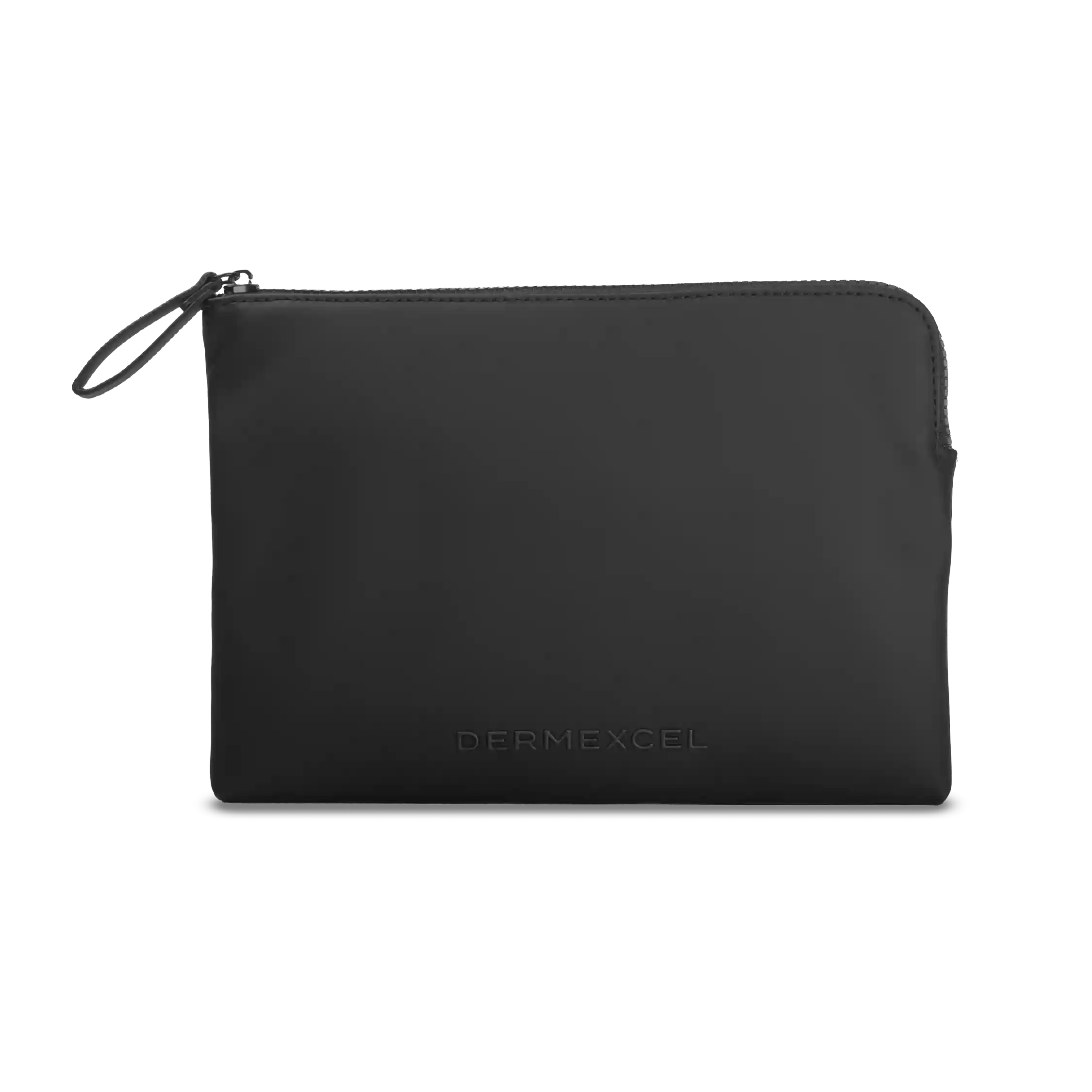

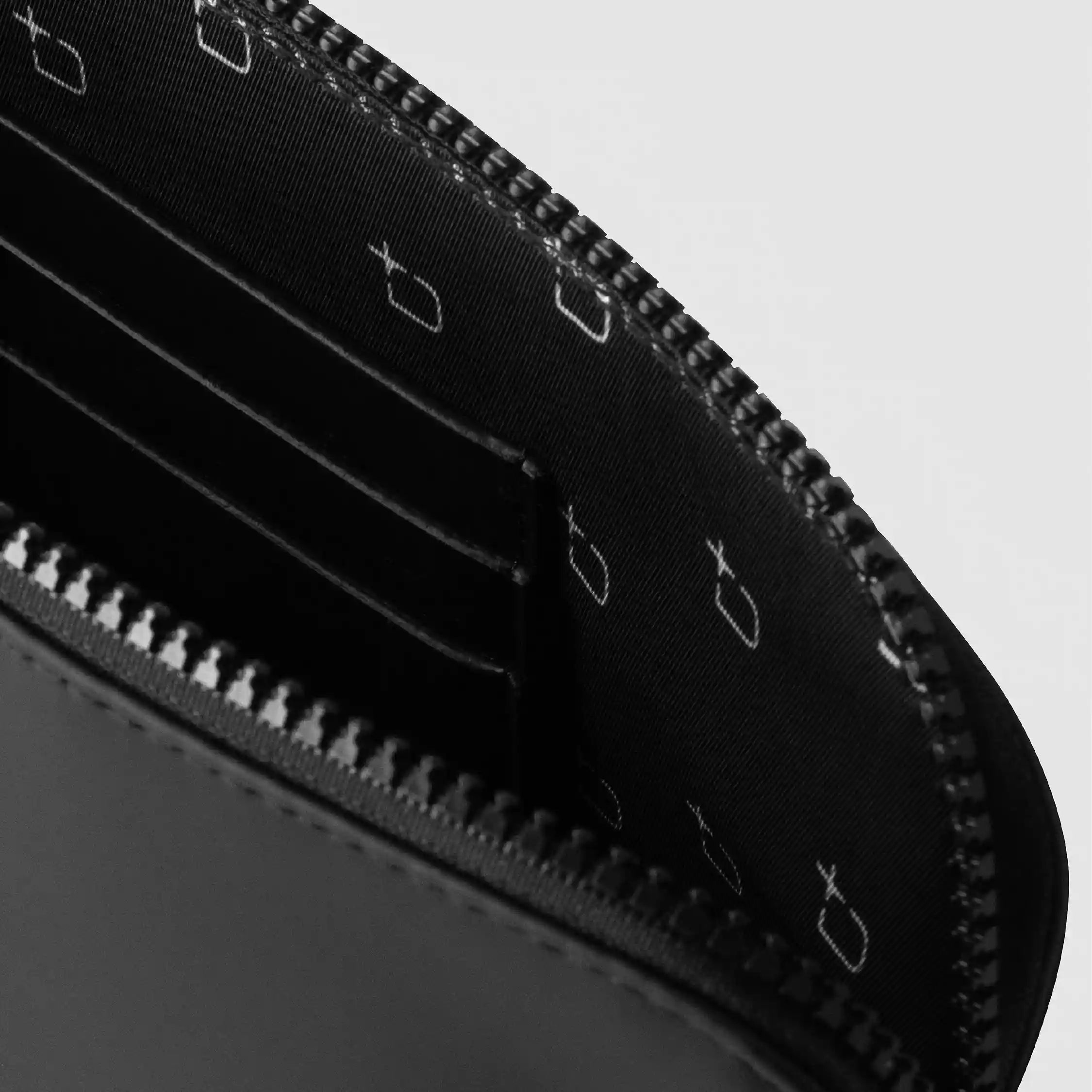

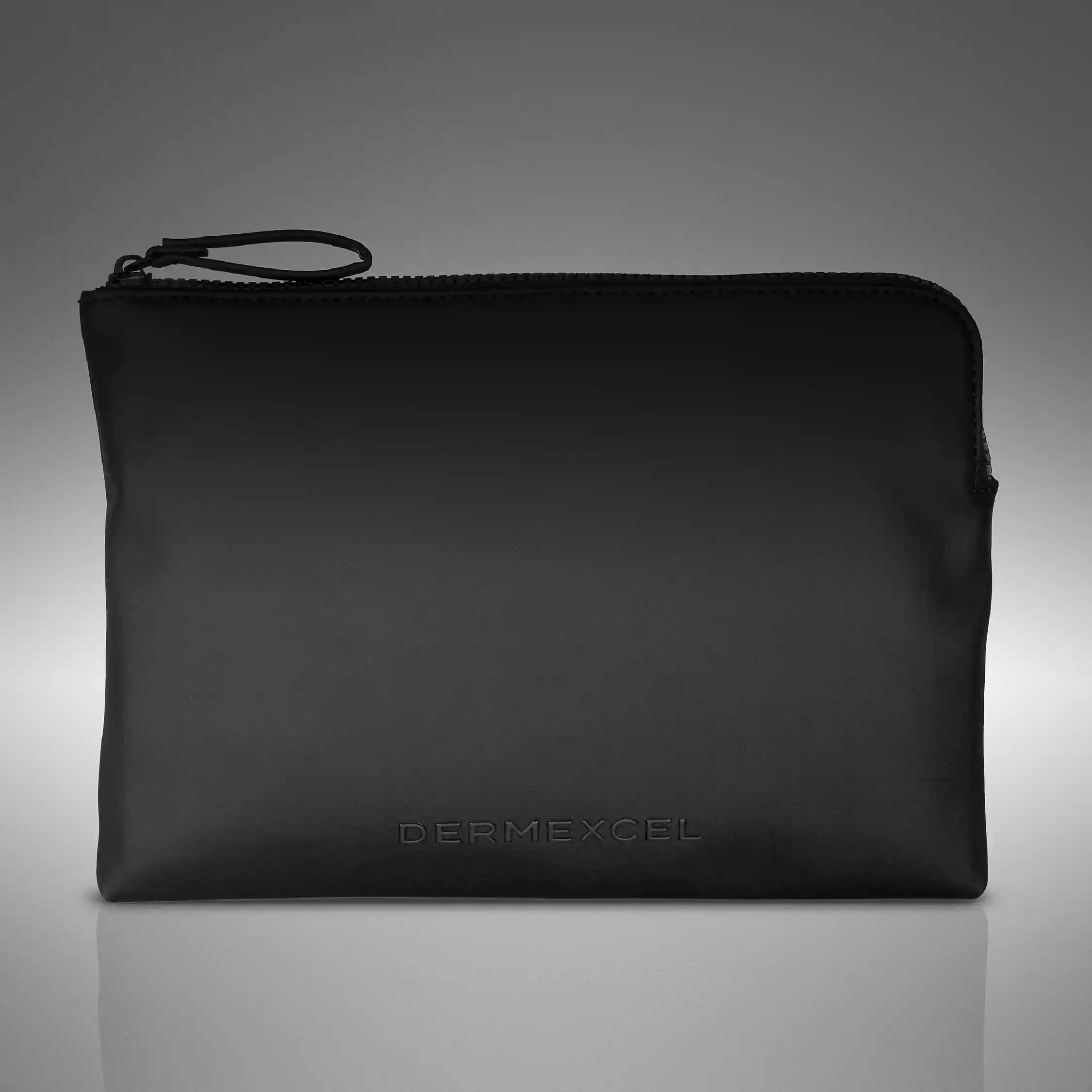




Sleek, structured, and thoughtfully crafted—this pouch is an elevated essential for the modern minimalist.
Designed with a matte silicone-coated finish, it offers a soft-touch feel with a distinctly sophisticated edge. A robust, chunky zipper glides with unwavering smoothness to reveal a sumptuous, fully lined interior—complete with a discreet zip compartment and three integrated card slots- so your cosmetics, cards, or tech accessories remain impeccably organized. Subtle tonal silicone branding whispers exclusivity.
Versatile enough to accompany you from the boardroom to the boarding gate, the Voyageur Noir Pouch transforms everyday essentials into an object of sophistication and purpose. It’s more than a pouch - it's a statement of refined taste.
Features:
- Three integrated credit card slots for seamless organisation
- An internal zip compartment to safeguard smaller valuables
- A looped zip puller that adds both ease and elegance
Size: H18.5cm x W26cm x D1.5cm
Material: 100% Polyurethane
Lining: 50% Recycled Polyester
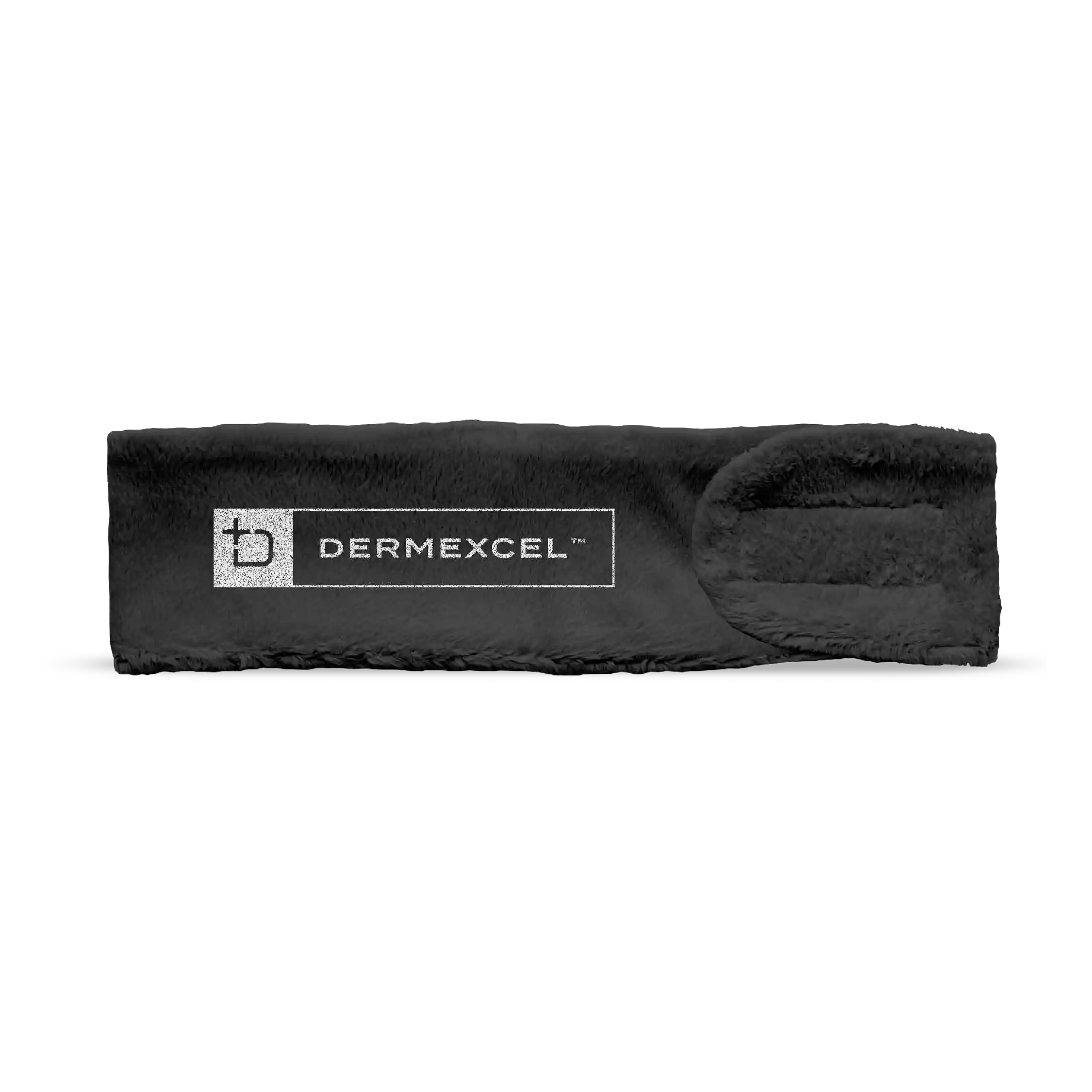

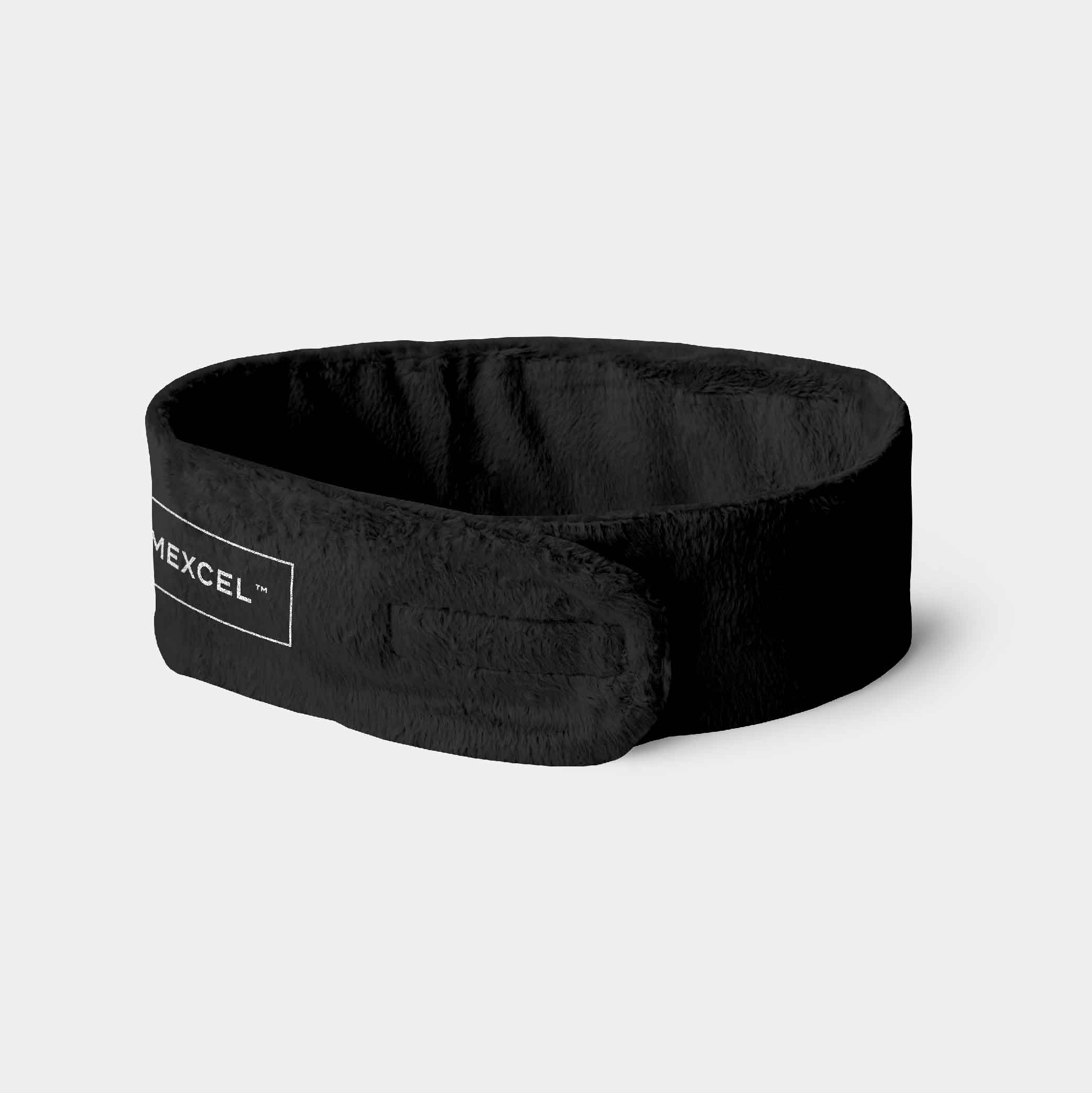






The DermExcel™ Headband is a simple yet essential accessory that enhances any skincare routine. Made from soft, high-quality microfibre fabric, it gently keeps hair away from the face without tugging or slipping—allowing you to focus fully on cleansing, masking, or applying your favourite products. Its absorbent material also helps manage moisture during treatments, making it especially useful during facials or when washing your face.
Designed for comfort and reusability, the headband features a secure velcro fastening that adjusts easily to fit all head sizes. The signature DermExcel logo is placed for a subtle, stylish finish that complements any self-care ritual. Whether at home or in a professional setting, it’s the perfect companion for clean, focused, and mess-free skincare application.


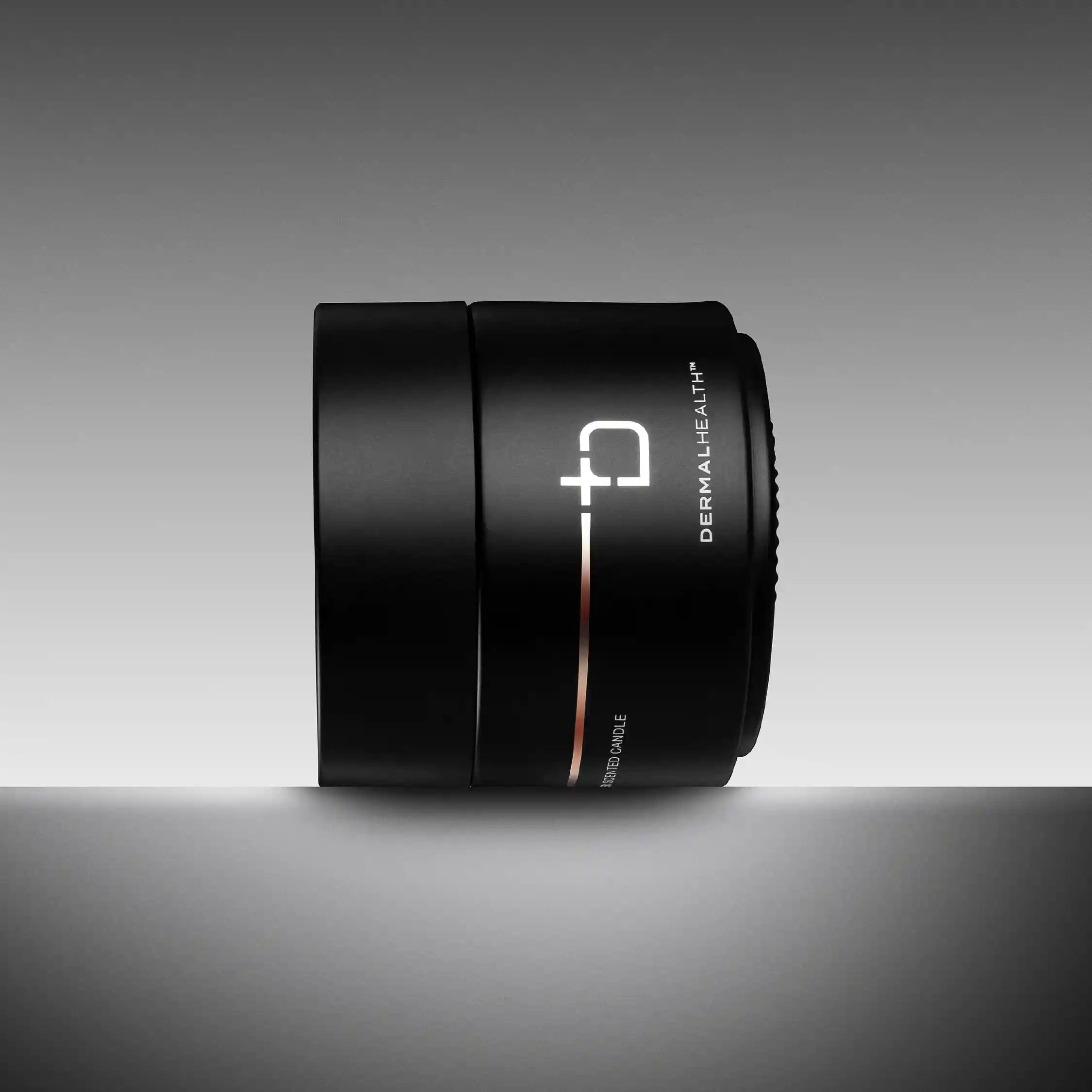




The Dermal Candle is a sensory statement, elegant, grounding, and quietly powerful. Its signature fragrance, Silent Prayer, is infused with the richness of Ebony Agarwood, a note long valued for its depth and complexity. The scent carries warm, resinous layers with earthy undertones, creating a sophisticated atmosphere of calm and presence.
This is a fragrance that holds space. It evokes the stillness of twilight, the comfort of solitude, and the depth of quiet reflection. It doesn’t seek attention, it creates intention.
Silent Prayer is more than fragrance.
It’s a mood. A moment to return to yourself.
A slow exhale. A pause that feels purposeful.
Perfect for any setting that calls for clarity, grounding, and understated luxury, The Dermal Candle brings a refined calm into the spaces you value most.
Testimonials
This hand treatment is the best for dry hands work perfectly for your hands. Best product for your hands.
This was an excellent gift and I needed all the products put together in the gift.
I absolutely love these products, I’ve been using the range for 3 years now and will it change!!
Love it!
Wooow I am glowing I love 💖 it.
Thank you Dermal
Just the perfect gift for any mom or even yourself! Has just the right selection of products.










